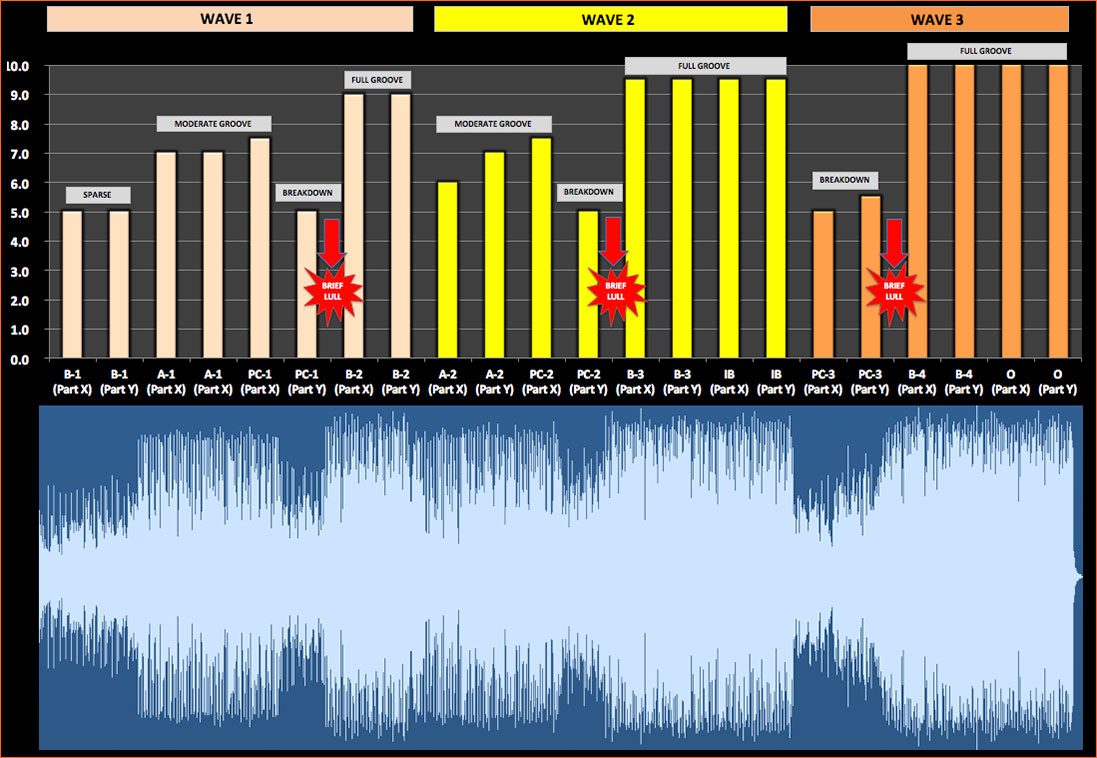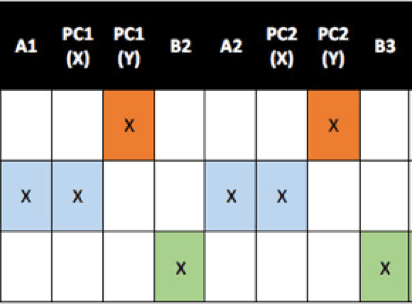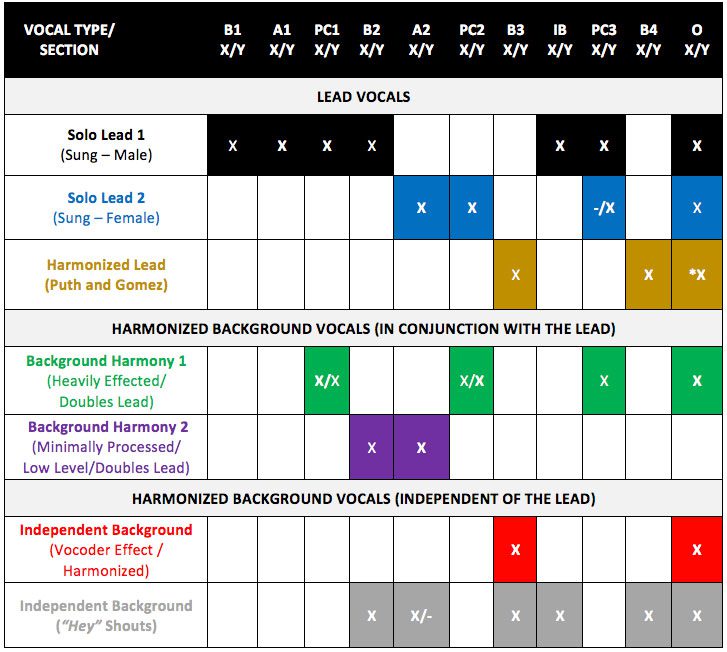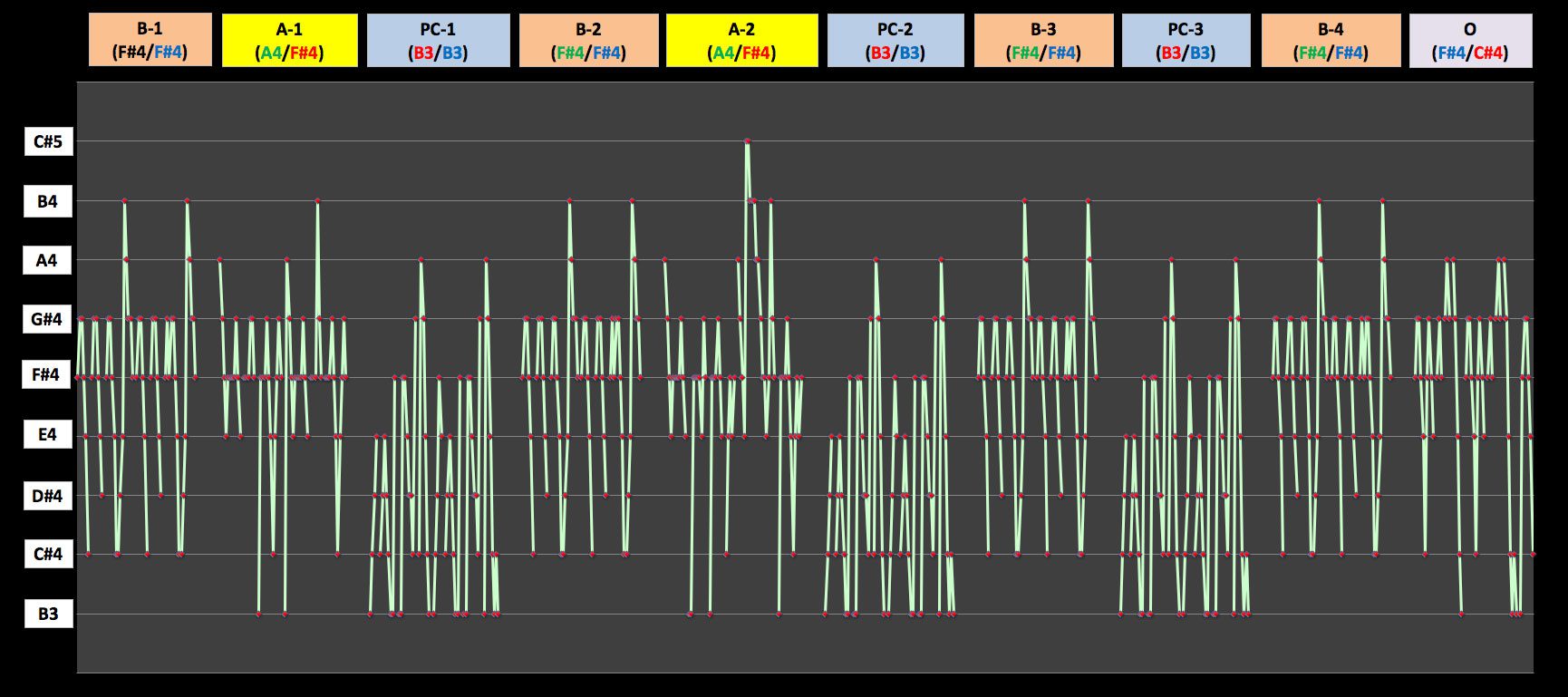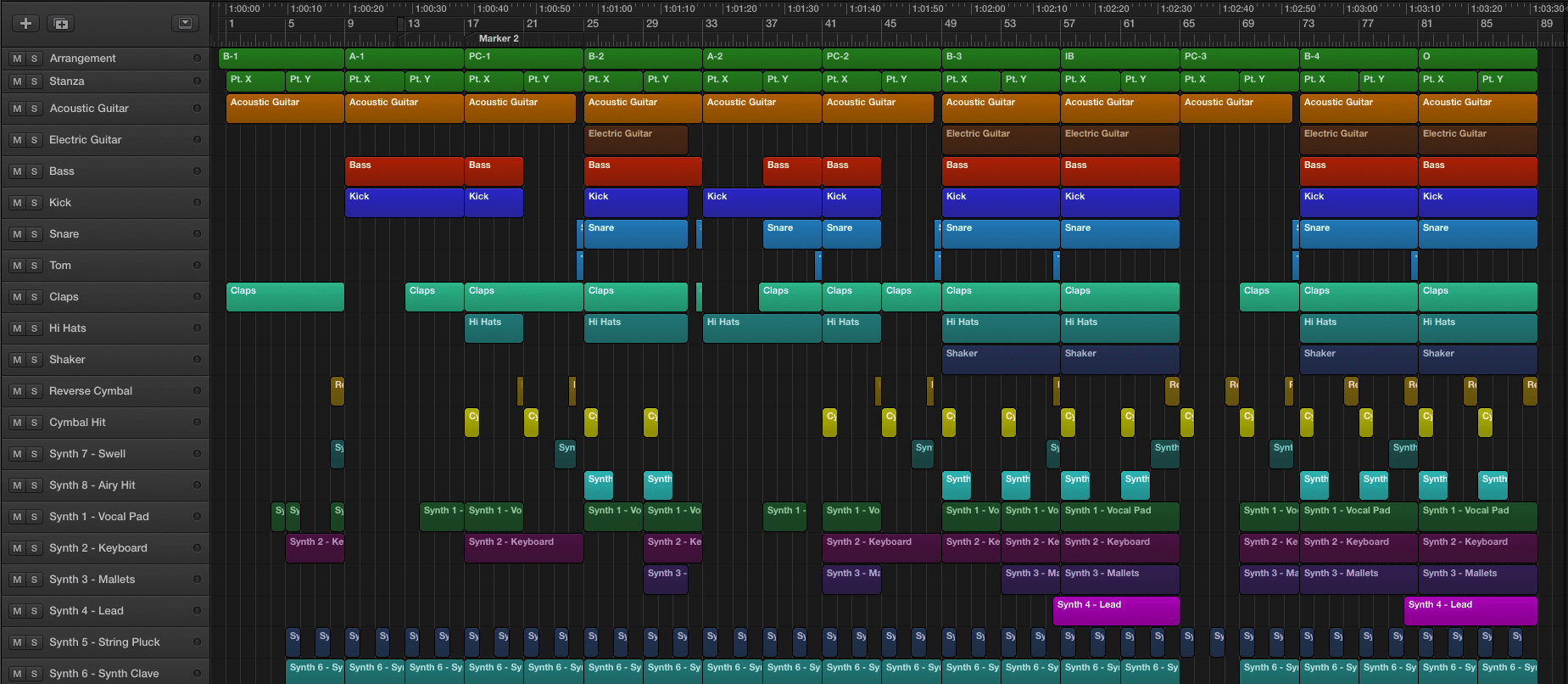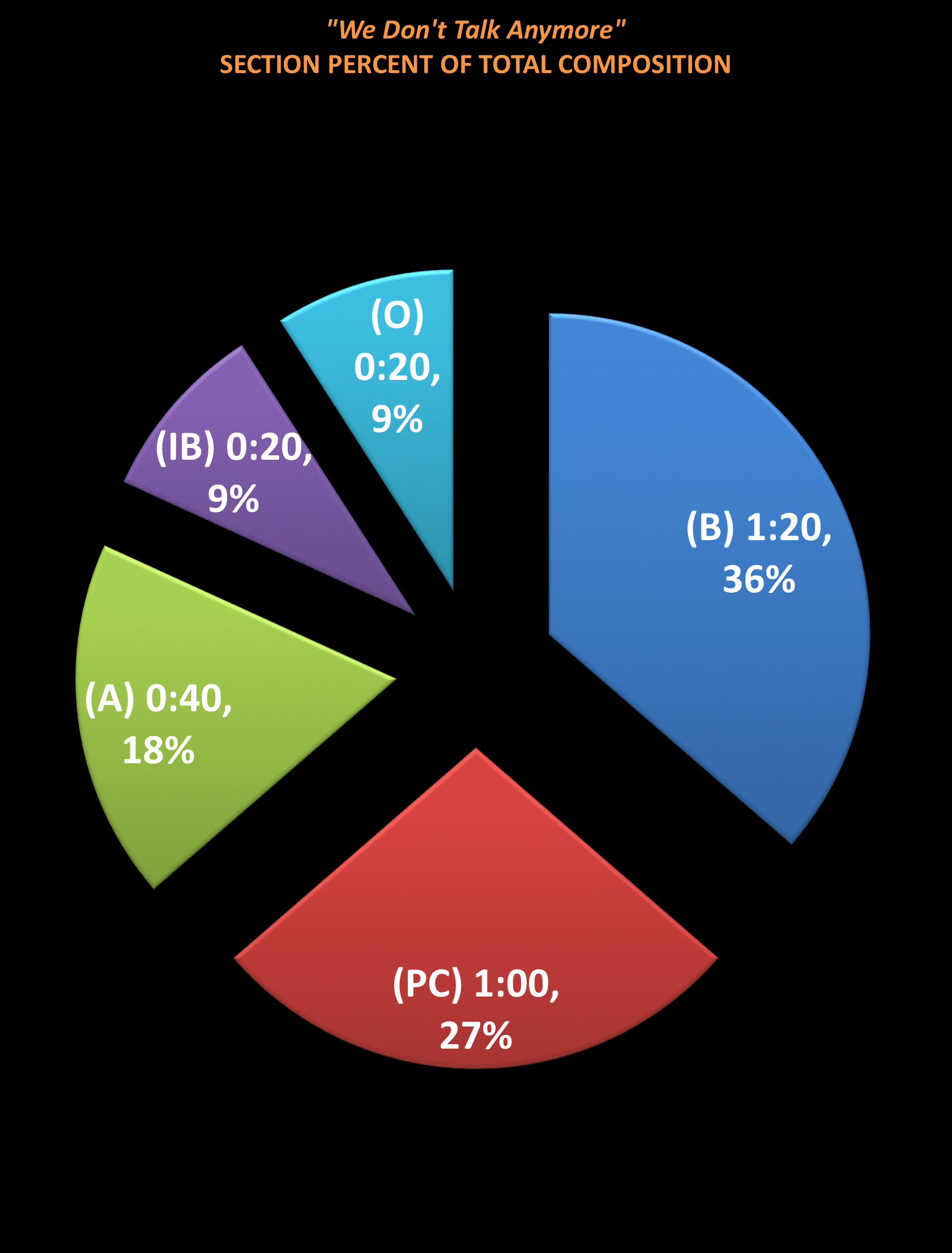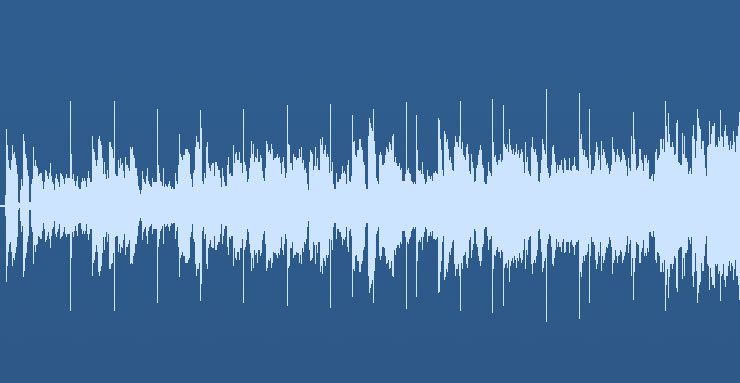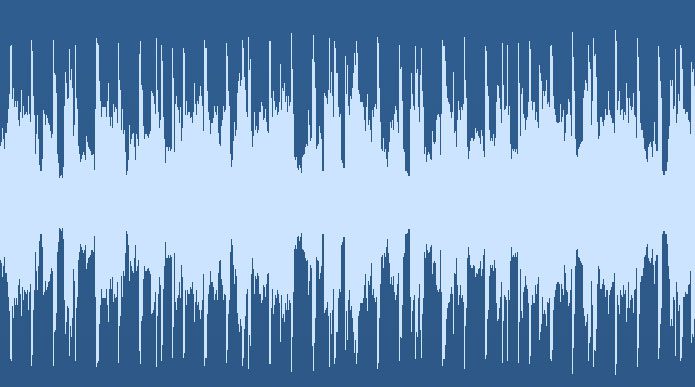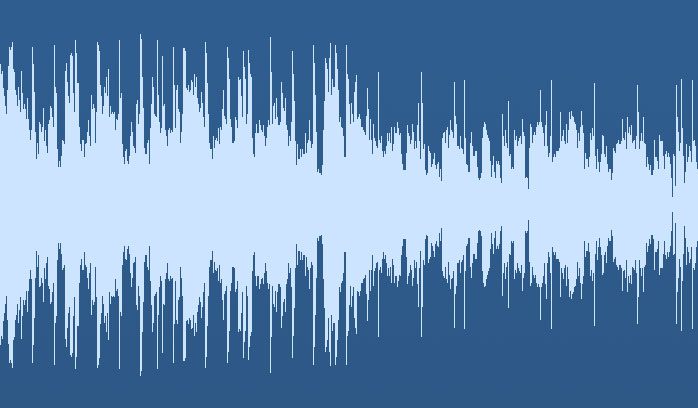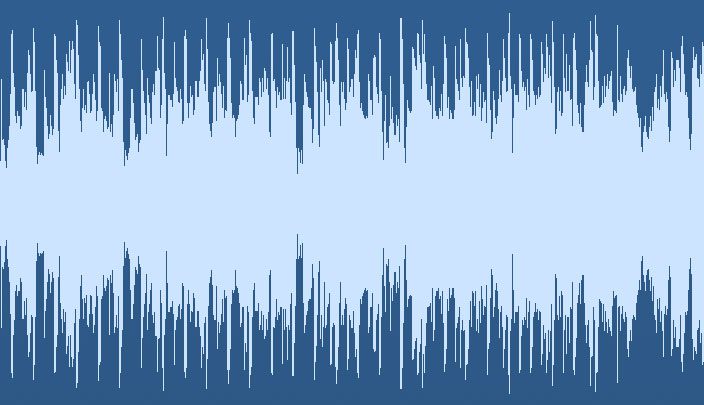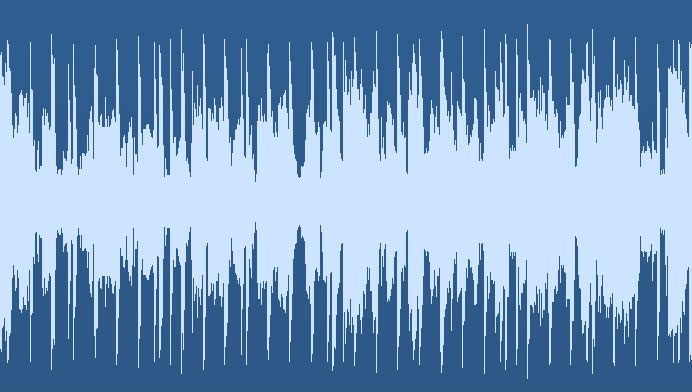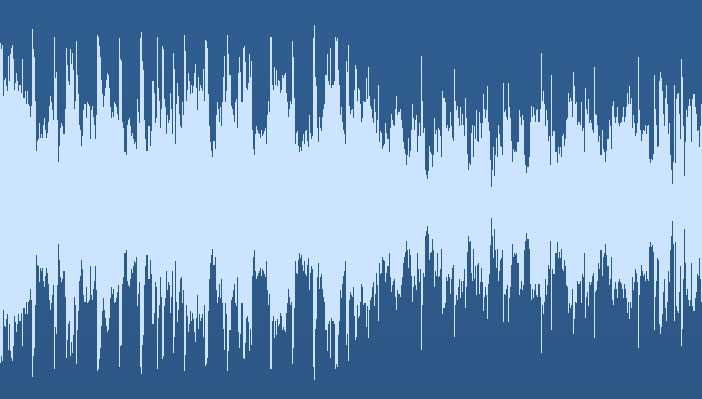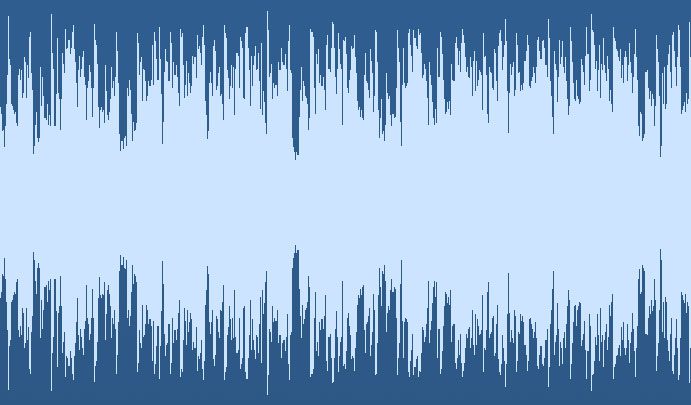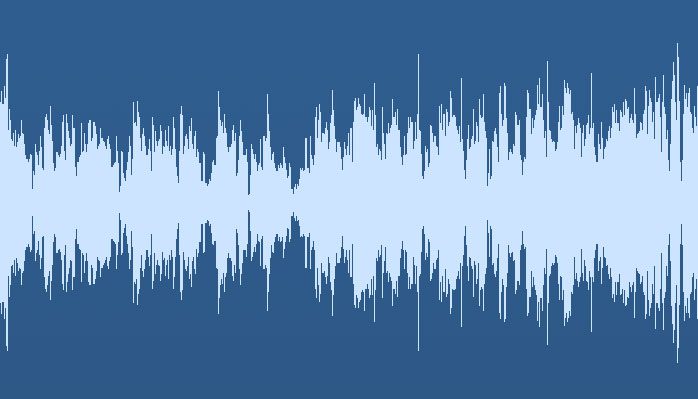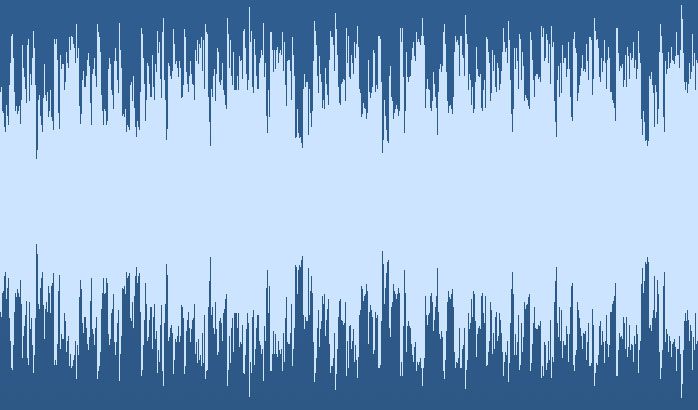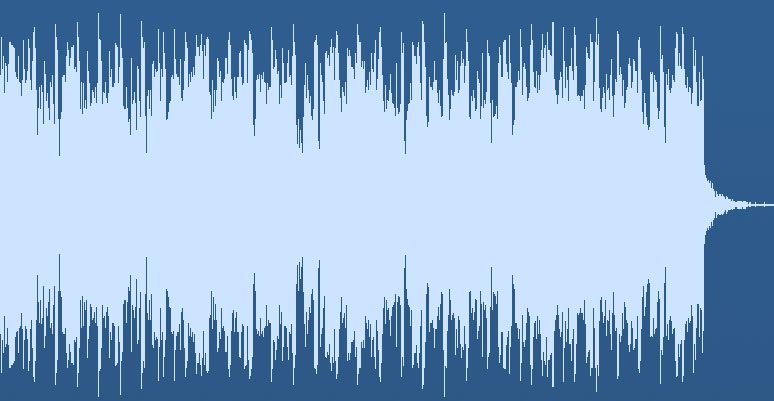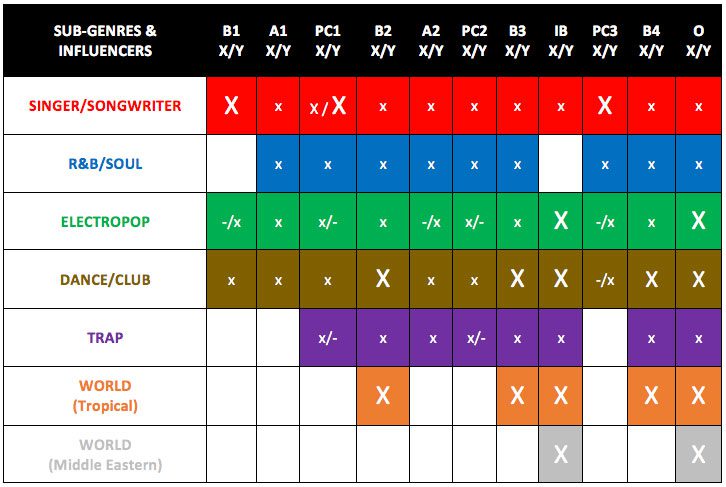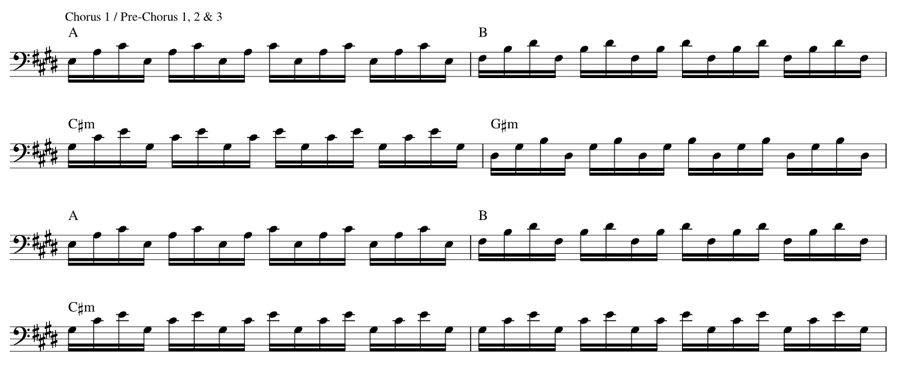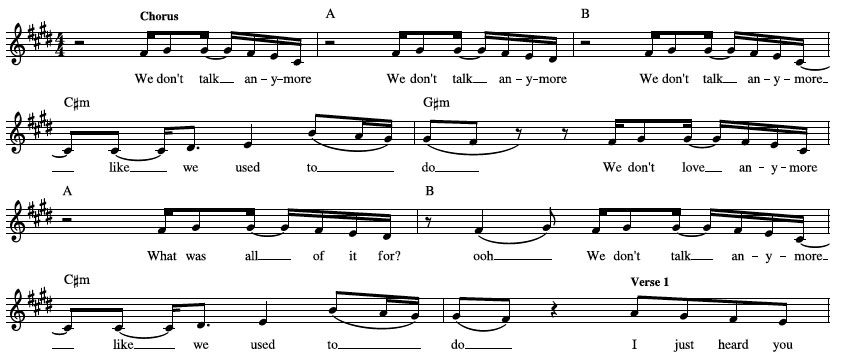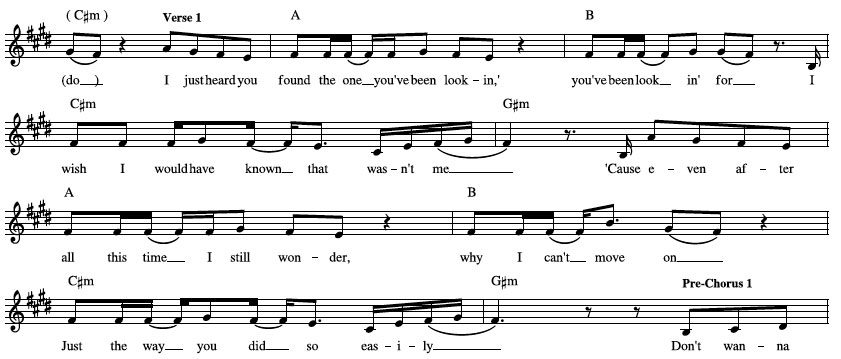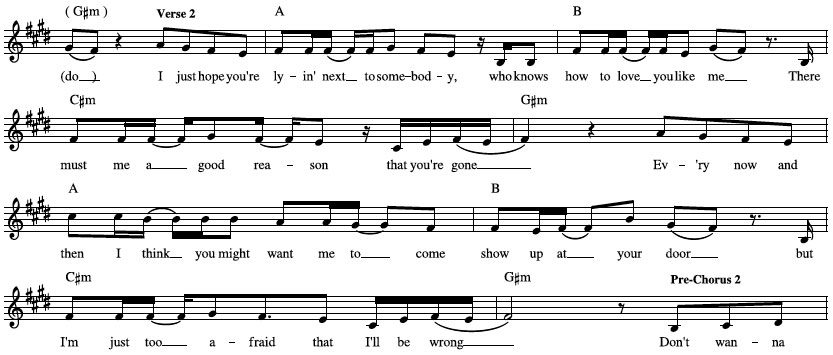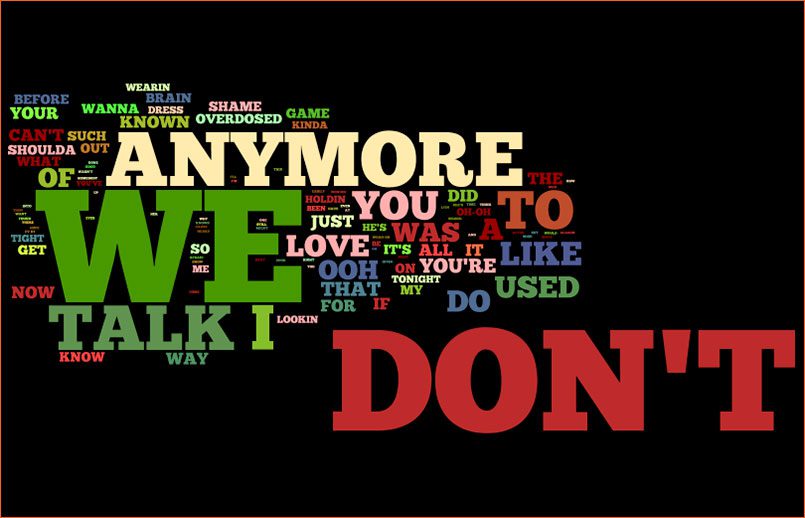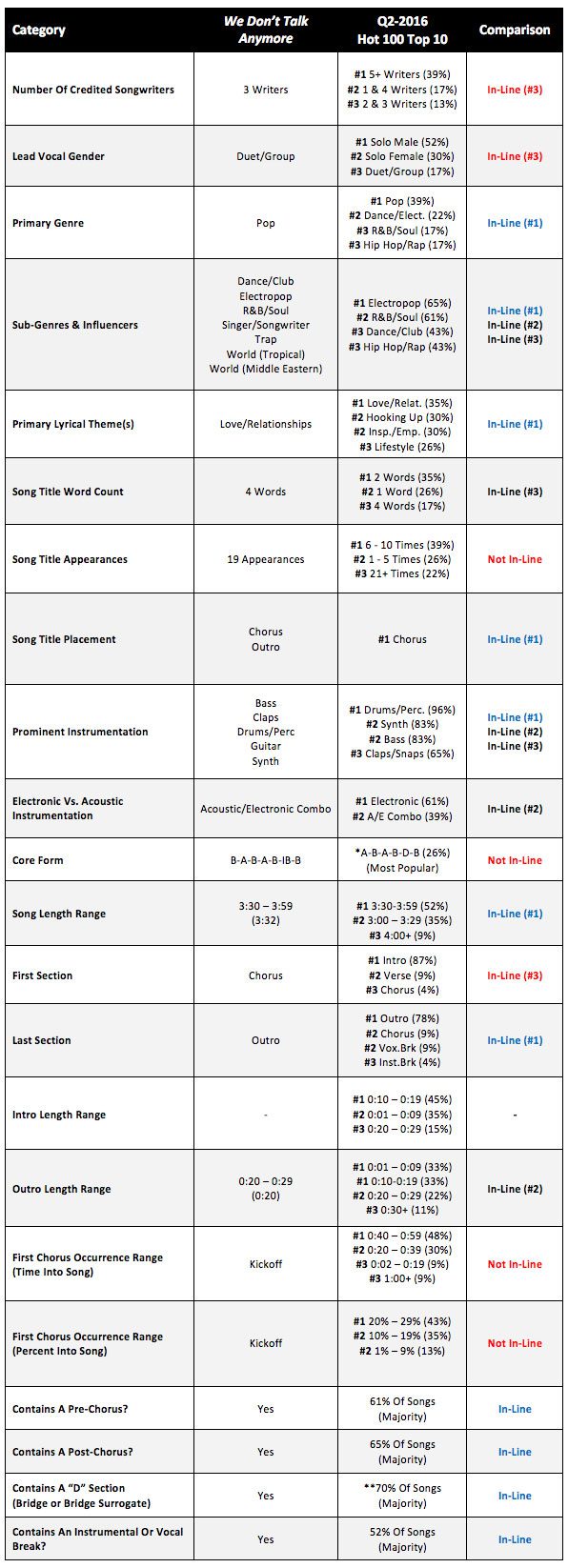To read this report, please log in.
Log in
We Don’t Talk Anymore is the third single released from Charlie Puth’s debut studio album, Nine Track Mind. It was written by Puth, Jacob Kasher, and the song’s featured artist, Selena Gomez.
This meticulously well-crafted song is a playbook of hit songwriting techniques. It features an outro that is a clever hybrid of the song’s three most infectious sections – the pre-chorus, chorus, and instrumental break. The engaging duet structure between Puth and Gomez accentuates the impact of the narrative, and its effective genre/influencer blend capitalizes on some of the hottest trends in today’s mainstream music scene.
In this report we dive into all of these hit songwriting techniques and much more.
Overview, Highlights & Takeaways >>
Momentum/Tension/Intensity (MTI)/Energy/Waveform >>
At a Glance
Artist: Charlie Puth featuring Selena Gomez
Song: We Don’t Talk Anymore
Songwriters: Charlie Puth, Jacob Hindlin, Selena Gomez
Producer: Charlie Puth
Record Label: Atlantic
Genre: Pop
Sub Genres/Influencers: Dance/Club, Electropop, World (Reggae/Tropical/Dancehall), Singer/Songwriter, R&B/Soul, Trap/Snap/Crunk
Length: 3:03
Structure (Core Form): B-A-B-A-B-IB-B
Key: C# Minor
Tempo: 100 BPM
First Chorus: Kickoff (0:00)
Intro Length: N/A
Electronic vs. Acoustic: Electronic/Acoustic Combo
Prominent Instrumentation: Bass (Synth), Claps, Guitar (Acoustic), Drums/Perc, Synth, Mallets, Electric Guitar
Primary Lyrical Theme(s): Love/Relationships
Title Appearances: We Don’t Talk Anymore appears 19 times in the song
Lyrical P.O.V: 1st and 2nd
Overview, Highlights & Takeaways
The lead synth featured in the instrumental break post chorus and outro delivers We Don’t Talk Anymore’s primary instrumental hook. It possesses a vocal characteristic, similar in timbre to the synths found in other recent Top 10 hits such as Major Lazer’s Lean On featuring MØ, and Seeb’s remix of Mike Posner’s I Took a Pill in Ibiza. It has an exotic, “snaking” vibe, recalling sounds of flutes in the Middle East, which provides the song with an additional World influence.
Its repetitive A-A-A-B phrase structure coupled with the simplicity of the progression and unique timbre in the song enables this hook to easily stand out, connect, and get ingrained in the listener’s head.
The song title We Don’t Talk Anymore functions as both the song’s primary lyrical hook and vocal hook.
In the first stanza/part X of the chorus, the song title hook is repeated three consecutive times in a very similar manner. This, coupled with the half rest that follows the first two occurrences enables the title hook to easily connect and resonate with the listener.
The second stanza/part Y features an almost identical melodic structure as part X, save for the “oo-ooh” vocal that follows line 2. However, note that the lyrics are different on lines 1 and 2. Despite the lyrical differences, the song title hook melody is further reinforced with the listener.
The song title hook vocal duties are changed up throughout the song, which helps to keep it fresh and engaging despite its repetitive characteristics:
- Chorus 1: Puth
- Chorus 2: Puth
- Chorus 3: Puth and Gomez (Gomez is at the forefront of the mix)
- Chorus 4: Puth and Gomez
- Outro: Puth and Gomez (Puth is at the forefront of the mix. Gomez enters on the very last line)
The song title hook is conveyed by Puth in both a similar and infectiously changed up manner in the outro compared to the chorus sections. As a result, the similarity reinforces the hook with the listener, while the differences helps keep it fresh and engaging – in addition to providing Puth with another opportunity to show off his vocal chops.
Additionally, the final “we don’t talk anymore” statement in the song is conveyed by both Puth and Gomez concurrently. Gomez’s vocal is spoken, heavily effected, and possesses a telephone / answering machine effect, which is unique in the scope of the song.
The chorus functions as the song’s primary sectional payoff, as it is arguably the most infectious, engaging, and memorable section of the song, and provides the summation of the narrative. However, the instrumental break post chorus and outro are exceptionally infectious and satisfying as well, and serve as secondary payoffs in the scope of the song.
Form: At its core, We Don’t Talk Anymore follows a B-A-B-A-B-IB-B form (chorus – verse – chorus – verse – chorus – instrumental break – chorus). It contains pre-chorus and outro sections in its framework as well. What it DOESN’T contain is an intro or narrative-advancing bridge. Additionally, the instrumental break section that follows the second chorus serves as an infectious post chorus due to the additional hook that it houses. Full Form: B / A-PC-B / A-PC-B / IB-PC-B-O
Section Length: Each full section in the song is ~20 seconds/8 bars long, and broken into two ~10 second/4-bar parts/stanzas.
Sectional Time Allocation: As is typically the case in mainstream hits, the chorus is allocated the greatest amount of time relative to all of the other sections, comprising 36% of We Don’t Talk Anymore’s total composition. The pre-chorus follows at 27% (9% less than the chorus), the verse at 18% (9% less than the pre-chorus), and the instrumental break and outro both at 9% (9% less than the verse).
First Chorus Appearance: We Don’t Talk Anymore kicks off with the chorus. As a result, the listener is immediately introduced to the song’s primary sectional payoff and vocal/lyrical hooks.
Sectional Segmentation: Many Top 10 hits break longer-length sections into shorter segments (i.e. parts/stanzas) to help keep the engagement factor at a high through the introduction of changed up or new material. In We Don’t Talk Anymore, this is put into effect in each section of the song. Each part/stanza pair possesses both similar and contrasting characteristics relative to one another, which ensures that the memorability factor of the full section is kept at a high, while at the same time preventing things from becoming overly monotonous.
The majority of songs that land in the Hot 100 Top 10 contain two pre-chorus sections in their framework. We Don’t Talk Anymore goes against the grain with three. The only other Top 10 hits since the beginning of 2016 that contain three pre-chorus sections in their framework are Don’t Mind, No, and Send My Love (To Your New Lover). In the case of We Don’t Talk Anymore, its unique full breakdown characteristic compared to the other pre-chorus sections provides an important departure where one would typically expect to find a bridge, along with the preceding instrumental break.
Of all the sections in the song, the outro is arguably the cleverest, and one of most engaging. It is essentially a hybrid of the song’s three most infectious sections – the pre-chorus, chorus, and instrumental break. As a result, the listener is left with some of the song’s most infectious and memorable elements resonating in their head at the conclusion.
Outro Accompaniment
- Chorus: Main backing music
- Instrumental Break: Primary instrumental hook
Outro Vocals/Lyrics
- Pre-Chorus: The bulk of lyrics from pre-chorus 1 are sung with a heavy vocoder effect a la Daft Punk’s Get Lucky. The exception occurs at the end of each stanza, which features Selena Gomez minus the effected vocals.
- Chorus: Puth sings the title lyrics at the beginning of the first and second stanzas, and joins together with Gomez on the last iteration of the title in the section. Additionally, the background vocal “hey” shouts from the chorus are featured as well.
- New Vocal/Lyrical Elements: Puth sings nonsense “oh-oh” and “whoa-oh” lyrics at the end of lines 2 and 3 in part X, and 6 and 7 in part Y.
We Don’t Talk Anymore features a high degree of dynamic variety – from low-energy breakdowns and transitional lulls to multi-sectional periods of sustained intensity. Together, they provide the listener with a highly dynamic and engaging listening experience.
The song progresses through three MTI/Energy level “waves.” Each wave begins with a relatively low energy level, and concludes with an energy level peak.
- Wave 1: Chorus 1 – Chorus 2
- Wave 2: Verse 2 – Instrumental Break
- Wave 3: Pre-Chorus 3 – Outro
Key
A=Verse, PC=Pre-Chorus, B=Chorus, IB=Instrumental Break, O=Outro
X/Y: First Stanza/Second Stanza
In the second half of the song, the listener is kept in the high-energy/full Dance groove for two consecutive sections:
- Chorus 3 through the Instrumental Break
- Chorus 4 through the Outro
These two energy level peaks are broken up by pre-chorus 3, which is a breakdown (i.e. possesses a very sparse characteristic relative to other sections). Note that pre-chorus 3 is the only pre-chorus in the entire song that remains in breakdown mode throughout the entire section, as opposed to only the second half. This sustained breakdown is fitting because it is surrounded by multiple high energy sections.
Each chorus in the song is preceded by a synth swell/lull/drum fill transition. The lull and thinned out accompaniment heightens the impact of the powerful full-accompaniment chorus that follows.
We Don’t Talk Anymore is a Pop song with Dance/Club, Electropop, R&B/Soul, Singer/Songwriter, Trap, and World (Tropical and Middle-Eastern) influences. These influences are present in the characteristics of the vocals, backing music, or both, in specific sections and in varying degrees of prominence throughout the song.
We Don’t Talk Anymore capitalizes on some of the hottest trends in today’s mainstream music scene, which accentuates the song’s ability to easily connect with a wide audience.
They include:
Folk, Singer/Songwriter: Put in to effect by acoustic guitar qualities similar to those found in found in Treat You Better and Stitches (Shawn Mendes), and more.
R&B/Soul: Particularly put into effect by the passionate, soulful vocals similar to those heard songs such as Pillowtalk (ZAYN), and 7 Years (Lukas Graham).
Trap: The sub bass and rapid-fire hi hats are also heard in recent hits including Don’t Let Me Down, Pillowtalk, and Work From Home.
Tropical and Dance/Club: Dance/Club-natured Tropical grooves and sounds are heard in diverse hits including Cheap Thrills, One Dance, Cold Water and Treat You Better.
Vocal Synths: Synths with a heavily pitch-processed vocal quality have been featured in big summer hits in both 2015 and 2016 including I Took A Pill In Ibiza (Mike Posner – Seeb Remix), Lean On (DJ Snake, Major Lazer, MØ), Sorry & What Do You Mean (Justin Bieber), and Where Are U Now (Jack U).
We Don’t Talk Anymore traverses through three groove levels – lite, moderate, and full, creating a dynamic and engaging ride for the listener. The level of groove is affected by the sparseness or fullness of the accompaniment in specific sections throughout the song.
Key
A=Verse, PC=Pre-Chorus, B=Chorus, IB=Instrumental Break, O=Outro
X/Y (In the header): First Stanza/Second Stanza
The song begins with a lite groove in the first chorus, and moves into a moderate groove in the first verse and the first half (part X) of the pre-chorus once the four-on-the-floor kick is added into the mix. The groove scales back to lite in the second half of the pre-chorus, which provides the full groove chorus that follows with a greater degree of perceived impact.
The pattern then repeats in the second verse, pre-chorus, and third chorus.
The instrumental break that follows the third chorus keeps the listener locked in full-groove mode, and then scales back to lite once again in the third pre-chorus, which provides engaging contrast. The song then launches back into full-groove mode once again in the fourth chorus, and remains in effect throughout the outro.
We Don’t Talk Anymore is a downtrodden love/relationship-themed song about two people who were involved in a relationship, broke up, still care for one another, and are trying to remain as friends or acquaintances. However, neither wants to know of the other’s new relationship exploits, hence the wrench in them still talking.
It’s communicated primarily in the past and present tense from a first and second person P.O.V. The narrative makes good use of detail and emotion, and the P.O.V. shifts between the protagonist and antagonist throughout the song makes for a highly engaging listen. Additionally, The narrative is communicated in a universal manner, which enables it to easily connect and resonate with a wide audience.
The impact of the narrative (and the song as a whole) is accentuated by the clever and effective structuring of the Puth (protagonist) / Gomez (antagonist) duet:
Chorus
- Chorus 1: Protagonist
- Chorus 2: Protagonist
- Chorus 3: Antagonist
- Chorus 4: Protagonist and Antagonist
Verse
- Verse 1: Protagonist
- Verse 2: Antagonist
Pre-Chorus
- Pre-Chorus 1: Protagonist
- Pre-Chorus 2: Antagonist
- Pre-Chorus 3: Protagonist and Antagonist
Outro
- Protagonist and Antagonist
Most Top 10 hit pre-choruses typically feature the same lyrics from occurrence to occurrence. However, that is only partially the case with We Don’t Talk Anymore. Consisting of two parts/stanzas, each pre-chorus features core lyrical similarities, but also contains changeups depending on whether the lyrics are being delivered by the protagonist or antagonist.
Pre-Chorus Commonalities
First Stanza/Part X: Each begins and ends with the same lyrics, which relate to both the protagonist and antagonist:
- Line 1: Don’t wanna know
- Line 4: The way I did before
Second Stanza/Part Y: Features the same lyrics from occurrence to occurrence, relating to both the protagonist and antagonist:
- Line 5: I overdosed
- Line 6: Shoulda known your love was a game
- Line 7: Now I can’t get you out of my brain
- Line 8: Ooh it’s such a shame
Pre-Chorus Differences
Lines 2 and 3 in part X of each pre-chorus relate specifically to the protagonist or antagonist:
Pre-Chorus 1 (Protagonist)
- Line 2: Kinda dress you’re wearin’ tonight
- Line 3: If he’s holdin’ on to you so tight
Pre-Chorus 2 (Antagonist)
- Line 2: If you’re lookin’ into her eyes
- Line 3: If she’s holdin’ on to you so tight
Pre-Chorus 3 (Protagonist)
- Line 2: Kinda dress you’re wearin’ tonight
- Line 3: If he’s givin’ it to you just right
The narrative is communicated in a universal manner, which enables it to easily connect and resonate with a wide audience. Since there is no mention of specific details that relate to both the protagonist and antagonist (i.e. the specific reason for their breakup, or the specifics regarding their relationship), the listener can adapt the story to fit their own life’s circumstances.
Puth’s decision to feature Selema Gomez on the track was a good one beyond just what she could contribute vocally. Gomez’s fans are well aware of her relationship history with Justin Bieber, and as a result would be more intrigued to check out the song and get engrossed in the narrative to see how it possibly relates. Ultimately this will lead to increased exposure and sales of Puth’s song.
As a title, We Don’t Talk Anymore is on the generic end of the spectrum. However, its powerful connotation coupled with the “soap opera factor” (i.e. since Selena Gomez is featured on the track, can it possibly pertain to her ex Justin Bieber?) will further pique the curiosity of the listener to check out the song.
We Don’t Talk Anymore is featured 19 times throughout the song. It appears four times in each of the song’s four chorus sections – the first three in a back-to-back manner in the first stanza/part X, and once on the second to last line in the second stanza/part Z.
Its featured three times in the outro as well – at the beginning of each stanza as well as the last line in the entire song.
We Don’t Talk Anymore features a host of different vocal characteristics throughout the song. Among them are solo male (Charlie Puth), solo female (Selena Gomez), harmonized lead (Puth and Gomez), harmonized background in conjunction with the lead, and harmonized background independent of the lead. Multiple effects are employed as well, including varying degrees of reverb and delay, a vocoder effect, and a telephone / answering machine type effect. The manner in which these disparate characteristics interact throughout the song takes We Don’t Talk Anymore’s overall impact to a heightened level.
Key
A=Verse, PC=Pre-Chorus, B=Chorus, IB=Instrumental Break, O=Outro
X/Y (In the header): First Stanza/Second Stanza
The vocal melody in We Don’t Talk Anymore spans B3 to C#5. It adheres to the K.I.S.S. principal (keep it simple and singable) and features a strong blend of repetitive and contrasting characteristics, which keeps the melodies fresh, engaging and memorable throughout the song.
The chorus, as is typically the case in Top 10 hits, features the most straight-forward and repetitive melodic structure in the scope of the song. As a result, this is the section that most easily connects and resonates with the listener.
What follows is a breakdown of the melodic structure for each section in the song. As you will see, each stanza in each full section of the song possesses a very similar structure. As a result, the melody is reinforced with the listener on a pronounced level.
Key
Numbers: Each number in its respective section represents a particular motive. These motives possess either the same, or a very similar melodic structure.
(-): Divides each motive in a particular line
(/): Divides each line
Verse 1
- First Stanza (two lines): 1 – 2 – 2 / 2 – 3
- Second Stanza (two lines): 1 – 2 – 2 / 2 – 3
Verse 2
- First Stanza (two lines): 1 – 2 – 2 / 2 – 3
- Second Stanza (two lines): 1 – 4 – 2 / 2 – 3
Pre-Chorus
- First Stanza (four lines): 1 / 2 / 2 / 3
- Second Stanza (four lines): 1 / 2 / 2 / 3
Chorus
- First Stanza (four lines): 1 / 1 / 1 / 2
- Second Stanza (four lines): 1 / 1 / 3 – 1 / 2
Outro
The section is a hybrid of chorus and pre-chorus vocals. See the Vocal Melody section of the report for details.
We Don’t Talk Anymore features a combination of in-line, cross-line, and cross-stanza rhyme schemes, as well as repetitive lyrics – especially in the chorus. Together, they do a great job of bolstering the song’s memorability factor and engagement value.
Key
(/): Separates the first stanza from the second stanza.
- Verse 1: XAXA
- Verse 2: XAXA
- Pre-Chorus: ABBX / ACCC (each pre-chorus features the same rhyme scheme despite some changed up lyrics)
- Chorus: AAAB / AAAB
- Outro: ABBA / ACCC
We Don’t Talk Anymore features four primary instrument types in the mix that shape its sound and vibe – guitars, bass, synths, and drums/percussion.
Bass: The bass featured in We Don’t Talk Anymore is a deep sub bass. It has a very prominent low end and hardly any top end or attack.
Drums/Perc: An assortment of drums and percussion elements are featured throughout the song. They include:
- Cymbal (electronic)
- Claps (acoustic)
- Hi hats (electronic)
- Kick (electronic) – provides the song with its driving four-on-the-floor Dance/Club rhythm.
- Shaker (acoustic)
- Snare (acoustic/electric hybrid)
- Tom (acoustic)
Guitar: A fingerpicked acoustic guitar playing 16th note arpeggios is present in every section of the song. It is most prominent in the mix in the sections that feature the sparsest arrangement – the intro and the third pre-chorus. Electric guitar is featured in choruses 2, 3, & 4, the instrumental break, and the outro. It is palm muted, slightly overdriven, and plays a syncopated pattern that adds momentum to the sections in which it is featured.
Synths: A plethora of synths are used in We Don’t Talk Anymore. They include vocal-based synths, leads, keyboards, mallets and more. They provide the song with its Electropop influence and their respective qualities are in tune with the current state of the mainstream music scene.
Song Structure
At its core, We Don’t Talk Anymore follows a B-A-B-A-B-IB-B form (chorus – verse – chorus – verse – chorus – instrumental break – chorus). It contains pre-chorus and outro sections in its framework as well. What it DOESN’T contain is an intro or narrative-advancing bridge.
Full Form: B / A-PC-B / A-PC-B / IB-PC-B-O
The instrumental break that directly follows the second chorus serves as an infectious post chorus due to the additional hook that it houses. Additionally, the instrumental break and ensuing breakdown third pre-chorus function as “bridge surrogates” due to the departure they provide where one would typically expect to find a narrative-advancing bridge.
We Don’t Talk Anymore kicks off with the chorus and is directly followed by a 2x repeat of a verse – pre-chorus – chorus sectional progression. Following the third chorus, a differentiated sectional progression consisting of instrumental break – pre-chorus – chorus – outro ensues, followed by the song coming to its conclusion.
We Don’t Talk Anymore contains 11 sections in its framework. Each is composed of two parts/stanzas, which are denoted as part X and Y throughout the report.
- Two verse sections
- *Three pre-chorus sections
- Four chorus sections
- One instrumental break (post chorus) section
- One outro
*We Don’t Talk Anymore is one of only four Top 10 hits since the beginning of the year that contain three pre-chorus sections in their framework. The others are Don’t Mind, No, and Send My Love (To Your New Lover).
Each full section in the song is ~20 seconds/8 bars, broken into two ~10-second/4-bar parts/stanzas.
Many Top 10 hits break longer-length sections into shorter segments (i.e. parts/stanzas) to help keep the engagement factor at a high through the introduction of changed up or new material. In We Don’t Talk Anymore, this is put into effect in each section of the song. Each part/stanza pair possesses both similar and contrasting characteristics relative to one another, which ensures that the memorability factor of the full section is kept at a high, while at the same time preventing things from becoming overly monotonous.
Reference the Vocal and Music sections of the report for details.
As is typically the case in mainstream hits, the chorus is allocated the greatest amount of time relative to all of the other sections, comprising 36% of We Don’t Talk Anymore’s total composition. The pre-chorus follows at 27% (9% less than the chorus), the verse at 18% (9% less than the pre-chorus), and the instrumental break and outro both at 9% (9% less than the verse).
This section of the report focuses on the MTI/Energy (momentum, tension, intensity) and sonic levels in each section of the song.
We Don’t Talk Anymore features a high degree of dynamic variety – from low-energy breakdowns and transitional lulls to multi-sectional periods of sustained intensity. Together, they provide the listener with a highly dynamic and engaging listening experience.
The song progresses through three MTI/Energy level “waves.” Each wave begins with a relatively low energy level, and concludes with an energy level peak.
- Wave 1: Chorus 1 – Chorus 2
- Wave 2: Verse 2 – Instrumental Break
- Wave 3: Pre-Chorus 3 – Outro
In the second half of the song, the listener is kept in the high-energy/full Dance groove for two consecutive sections:
- Chorus 3 – Instrumental Break
- Chorus 4 – Outro
These two energy level peaks are broken up by pre-chorus 3, which is a breakdown (i.e. possesses a very sparse characteristic relative to other sections). Note that pre-chorus 3 is the only pre-chorus in the entire song that remains in breakdown mode throughout the entire section, as opposed to only the second half. This sustained breakdown is fitting because it is surrounded by multiple high energy sections.
Each chorus in the song is preceded by a synth swell/lull/drum fill transition. The lull and thinned out accompaniment heightens the impact of the powerful full-accompaniment chorus that follows.
We Don’t Talk Anymore’s first chorus features the lowest overall energy level in the entire song. This is due to the sparse arrangement, consisting of Puth’s tender, fragile vocal, claps, and a few synths that play a subtle role in the mix. However, note that the downtrodden lyrics (i.e. “we don’t talk anymore”) coupled with Puth’s delivery provides the section with an underlying tense of tension.
The MTI/Energy level is kicked up in the first verse due in part to the addition of the four-on-the-floor kick, sub bass, and the more animated quality of Puth’s lead vocals compared to the preceding chorus. Together they provide a heightened degree of momentum, power and intensity.
The MTI/Energy level in the first half of the pre-chorus (part X) is slightly above that of the preceding verse primarily due to the changeups in the vocal (e.g. ascending melody and background vocal additions). The characteristics of the accompaniment remain relatively on par. However, the MTI /energy level drops off significantly in the second half of the section (part Y) due to the removal of the four-on-the-floor kick and bass, which puts the song into breakdown mode. This results in less intensity and momentum compared to the first half of the section and the preceding verse.).
Toward the end of the pre-chorus, an airy synth swell and reverse cymbal swell effect enter the mix. They abruptly cut off at the end of beat 2 in the last measure, followed by the full accompaniment being pulled on beat 3. This creates a brief transitional lull under Puth’s “we don’t” vocal, followed by a snare/tom fill on beat 4. The thinned out accompaniment enables the full chorus to hit with increased perceived impact at the onset of the section.
The MTI/Energy level of the song is thrust up to its first peak in a pronounced manner in the second chorus due to the changeups in the accompaniment. The section features the fullest arrangement in the song thus far, and features the most pronounced, driving groove as well.
Following the chorus, the MTI/Energy level is brought down in the first half of the second verse (part X) due to the thinned out characteristic of the accompaniment (e.g. the bass and snare among other elements have been removed from the mix). However, note that the four-on-the-floor kick remains in effect, which keeps the Dance/Club influenced momentum in effect.
In the second half of the section the bass and snare return to the mix, which results in a higher intensity level compared to part X. Compared to its verse 1 counterpart, the MTI/Energy level is relatively on par.
The MTI/Energy level progression in the second pre-chorus is essentially the same as the first pre-chorus in the song. It begins at a slightly higher level than the preceding verse due to the changeup in the vocal (e.g. higher pitch, background vocal additions), and then drops off in the second half due to the thinned out accompaniment.
Essentially the same swell/lull/fill technique that was used to transition the first pre-chorus into the first chorus is utilized here as well.
The MTI/Energy level reaches its highest level thus far in the song in the third chorus. Its subtly higher than that of the second chorus primary due to the changeups in the vocal – in particular Puth harmonizing with Gomez’s lead and the addition of the “we don’t, we don’t” background vocals.
Following the third chorus, the MTI/Energy level remains relatively constant in the instrumental break primarily due to the accompaniment similarities between sections. The primary difference is that the lead synth has been substituted for the chorus vocals.
Following two back-to-back sections of sustained intensity, the MTI/Energy level is brought way back down in the first stanza/part X of the third pre-chorus due to its breakdown/sparse characteristics (i.e. vocal, guitar, synth plucks).
The level is kicked up a notch in the second half of the section due to the addition of the claps, synth vocal pad, electric piano synth, and mallets into the mix.
Essentially the same as the two previous chorus impact accentuators featured in the song.
Following the respite in the pre-chorus, the MTI/Energy level is thrust up to its peak in the fourth and final chorus. While the accompaniment characteristics are on par with the third chorus, the additional vocals and subtly higher levels provide for a higher degree of intensity.
The MTI/Energy level in the outro remains on par with that of the preceding chorus. As a result, the listener is kept at an excited high for two-straight sections, followed by the song abruptly cutting off at the end.
Genres, Sub-Genres, & Vibes
Many of today’s hits feature a fusion of different genres, sub-genres and influences that helps to achieve the following:
- Provide the song with a unique nature that enables it to stand out from its mainstream contemporaries via interesting and at times unconventional pairings.
- Increase the fan base and sales potential of the artist and song by traversing multiple genres.
We Don’t Talk Anymore is a Pop song with Dance/Club, Electropop, R&B/Soul, Singer/Songwriter, Trap, and World (Tropical and Middle-Eastern) influences. These influences are present in the characteristics of the vocals, backing music, or both, in specific sections and in varying degrees of prominence throughout the song.
Note that these influences are some of the hottest trends heard in current mainstream hits, which accentuates the song’s ability to easily connect with a wide audience.
Additionally, We Don’t Talk Anymore traverses through three groove levels, which maximizes its impact with the listener.
Key
x: The influence is heard in a specific section
X: The influence is prominent in a specific section
The entire song features a Singer/Songwriter influence, which is primarily put into effect by the characteristics of the acoustic guitar. Its most prominent in the first chorus and third pre-chorus where the guitar plays the central role in the mix, and takes more of a backseat in the other sections when the other accompaniment elements are in effect.
Each vocal section of the song save for the instrumental break features an R&B/Soul influence. Its most evident in the soulful, passionate characteristics of Puth’s delivery, and to a lesser extent Gomez’s, which leans more toward the Pop end of the spectrum.
Electropop plays a role in at least one part/stanza in each section of the song and is put into effect by the synths featured in the mix. The exceptions are:
- Chorus 1: Part X
- Pre-Chorus 1 & 2: Part Y
- Pre-Chorus 3: Part X
- Verse 2: Part X
The above parts/stanzas all feature a relatively sparse arrangement and do not contain any synths in the mix.
Each section of the song save for the first chorus and first part/stanza of the third pre-chorus possesses a Dance/Club influence, in varying levels of prominence.
The influence is most pronounced in the sections that feature the full drum groove and synth bass in the mix:
- Choruses 2, 3 & 4: Full section
- Instrumental Break: Full section
- Outro: Full section
The influence is less pronounced in the sections that feature a sparser accompaniment, but is kept in effect primarily by the four-on-the-floor kick, and to a lesser extent the claps:
- Verse 1: Full section
- Pre-Chorus 1: Full section (the kick is removed in the second stanza but the claps remain)
- Pre-Chorus 2: Full section (the kick and snare are removed in the second stanza but the claps remain)
- Verse 2: Full section (accentuated by the addition of the snare in the second part/stanza)
- Chorus 1: Full section (Claps only)
Additionally, a Daft Punk influence is put into effect by the harmonized/vocoder vocals in chorus 3 and the outro.
Trap plays a minimal role in the following sections:
- Pre-Chorus 1: Part X
- Pre-Chorus 2: Part X
- Verse 2
- Chorus 2, 3 & 4
- Instrumental Break
- Outro
The sub bass, rapid-fire hi hats, and claps provide a subtle Trap influence, which accentuates the song’s relevance in today’s mainstream music scene since Trap plays a significant role in various genres.
There are two World influences featured in specific sections – Tropical and Middle Eastern.
Tropical played a major role during the summer of 2016. Its influence was present in diverse hits including Cheap Thrills, Cold Water, Treat You Better, among others. We Don’t Talk Anymore capitalized on this trend, and is put into effect by the Reggae-influenced rhythms, light synths, and breezy grooves in the following sections:
- Chorus 2, 3 & 4
- Instrumental Break
- Outro
The instrumental break and outro sections feature a Middle Eastern influence, which is put into effect by the “snaking” qualities of the lead synth. It shares this characteristic in common with the lead synth featured in The Chainsmoker’s recent hit, Don’t Let Me Down.
We Don’t Talk Anymore capitalizes on some of the hottest trends in the mainstream music scene which accentuates its connection with a mainstream audience. They include:
- Folk, Singer/Songwriter: Put in to effect by acoustic guitar qualities similar to those found in found in Treat You Better, Stitches (Shawn Mendes), and more.
- R&B/Soul: Particularly put into effect by the passionate, soulful vocals similar to those heard songs such as Pillowtalk (ZAYN), and 7 Years (Lukas Graham).
- Trap: The sub bass, rapid-fire hi hats are also heard in recent hits including Don’t Let Me Down, Pillowtalk, and Work From Home.
- Tropical and Dance/Club: Dance/Club natured Tropical grooves and sounds are heard in diverse hits including Cheap Thrills, One Dance, Cold Water and Treat You Better.
- Vocal Synths: Synths with a heavily pitch-processed vocal quality have been featured in big summer hits in both 2015 and 2016 including I Took A Pill In Ibiza (Mike Posner – Seeb Remix), Lean On (DJ Snake, Major Lazer, MØ), Sorry & What Do You Mean (Justin Bieber), and Where Are U Now (Jack U).
We Don’t Talk Anymore traverses through three groove levels – lite, moderate, and full, creating a dynamic and engaging ride for the listener. The level of groove is affected by the sparseness or fullness of the accompaniment in specific sections throughout the song.
The song begins with a lite groove in the first chorus, and moves into a moderate groove in the first verse and the first half (part X) of the pre-chorus once the four-on-the-floor kick is added into the mix. The groove scales back to lite in the second half of the pre-chorus, which provides the full groove chorus that follows with a greater degree of perceived impact.
The pattern then repeats in the second verse, pre-chorus, and third chorus.
The instrumental break that follows the third chorus keeps the listener locked in full-groove mode, and then scales back to lite once again in the third pre-chorus, which provides engaging contrast. The song then launches back into full-groove mode once again in the fourth chorus, and remains in effect throughout the outro.
Primary Instrumentation
We Don’t Talk Anymore features four primary instrument types in the mix that shape its sound and vibe – guitars, bass, synths, and drums/percussion.
A fingerpicked acoustic guitar playing 16th note arpeggios is present in every section of the song. It is most prominent in the mix in the sections that feature the sparsest arrangement – the intro and the third pre-chorus. It imparts a Singer/Songwriter influence and is a prominent aspect of the song’s Pop vibe.
Electric guitar is featured in choruses 2, 3, & 4, the instrumental break, and the outro. It is palm muted, slightly overdriven, and plays a syncopated pattern that adds momentum to the sections in which it is featured. It also helps to put the Reggae/Tropical influence into effect.
The bass featured in We Don’t Talk Anymore is a remarkably deep sub bass. It has a very prominent low end and hardly any top end or attack. Despite being so present in the low end, it is never overbearing in the mix. It helps to put the Electropop and Dance/Club influences into effect, and is featured in the following sections:
- Verse 1 (X&Y)
- Pre-Chorus 1 (X&Y)
- Chorus 2, 3 & 4 (X&Y)
- Verse 2 (Y only)
- Pre-Chorus 2 (X only)
- Instrumental Break (X&Y)
- Outro (X&Y)
A plethora of synths are used in We Don’t Talk Anymore. They include vocal-based synths, leads, keyboards, mallets and more. They provide the song with its Electropop influence and their respective qualities are in tune with the current state of the mainstream music scene.
This synth has a vocal “ooh” texture, and is heavily processed with delay and reverb. It pops in and out of the mix in each section throughout the song, providing additional color and texture. Its character and timber are very much in line with today’s mainstream music scene.
The synth keyboard has a timbre similar to that of an electric piano, but more rounded and synthesized sounding. It plays block chords, which are sustained whole notes except in the third pre-chorus, where it plays a syncopated dotted quarter pattern. It appears in the following sections:
- Pre-chorus 1, 2 (X&Y)
- Pre-chorus 3 (Y only)
- Chorus 2 & 3 (Y only)
- Chorus 4 (X&Y)
- Instrumental break (X&Y)
- Outro (X&Y)
The mallets synth has a timbre like a marimba struck with hard mallets. It plays two distinct roles throughout the song:
Rolled chords
The rolled chords are played in the nature of a keyboard instrument, rolling up from the lowest note of the chord to the highest. The rolled chords appear in:
- Chorus 2 & 3 (Y only)
- Chorus 4 (X&Y)
- Pre-Chorus 2 (X only)
- Pre-Chorus 3 (Y only)
- Instrumental Break (X&Y)
- Outro (X&Y)
Syncopated, percussive groove
This part sounds like a more conventional, single-note marimba part playing a rhythmic, Reggae/Tropical influenced groove. It can be heard in:
- Chorus 2 & 3 (Y only)
- Chorus 4 (X&Y)
- Instrumental Break (X&Y)
- Outro (X&Y)
This lead synth has a vocal characteristic, similar in timbre to the synths found in other recent Top 10 hits such as Major Lazer’s “Lean On” featuring MO, and Seeb’s remix of Mike Posner’s “I Took a Pill in Ibiza.” It has an exotic, “snaking” vibe, recalling sounds of flutes in the Middle East, which provides the song with an additional World influence. It is featured only in the instrumental break and outro.
The string pluck has a timbre similar to that of a pizzicato violin, and is processed with reverb and a hint of vibrato. It is low in the mix and works rhythmically in conjunction with the synth clave. It is in effect in every section of the song, beginning with the second half of chorus 1.
The synth clave has a very percussive timbre, similar in timbre to a clave sound found on drum machines. It is processed with delay (with an apparent delay tail) and reverb. It works in conjunction with the string pluck in every section of the song beginning in the second half of chorus 1 except for the first half of pre-chorus 3 where it is pulled out.
Airy synth swells are implemented as transitional elements in the following sections:
- Chorus 1, 2, 3 & 4 (Part Y)
- Pre-Chorus 1, 2 & 3 (Part Y)
- Instrumental Break (Part Y)
This airy hit has a similar effect to that of a cymbal hit, but with much longer decay. It is heard in the following sections:
- Chorus 2, 3 & 4 (X&Y)
- Instrumental Break (X&Y)
- Outro (X&Y)
The electronic kick used in We Don’t Talk Anymore is thick and punchy, and plays a four-on-the-floor beat, which provides the song with a Dance/Club influence. It is featured in the following sections:
- Verse 1 & 2 (X&Y)
- Pre-Chorus 1 (X only)
- Chorus 2, 3 & 4 (X&Y)
- Instrumental Break (X&Y)
- Outro (X&Y)
The snare has a hybrid acoustic/electronic quality, with ample hi-end “snare” sound, but not a lot of midrange body. It accentuates the groove and functions in the manner of a transitional element as well, playing a fill sometimes along with the tom. It can be heard as part of the groove in the following sections:
- Chorus 2, 3 & 4 (X&Y)
- Verse 2 (Y only)
- Pre-Chorus 2 (X only)
- Instrumental Break (X&Y)
- Outro (X&Y)
It’s heard as a fill at the end of each pre-chorus section.
A low-pitched, relatively dry acoustic tom is heard in conjunction with the snare in the following cross-section transitional fills:
- Pre-Chorus – Chorus
- Verse 2 – Pre-Chorus 2
- Chorus 3 – Instrumental Break
- Chorus 4 – Outro
Dry, relatively subtle acoustic claps are featured throughout the song. They are present in every section of the song save for the third pre-chorus, mainly playing on beats 2 & 4.
The electronic hi hats play a glitchy pattern, which provides the song with a subtle Trap influence. This further accentuates the song’s relevance in the current mainstream music scene. Electronic hi hats are featured in the following sections:
- Pre-Chorus 1 & 2 (X only)
- Chorus 2, 3 & 4 (X&Y)
- Verse 1 (X&Y)
- Instrumental Break (X&Y)
- Outro (X&Y)
A low-level, small shaker similar in timbre to an egg shaker provides additional texture and ups the momentum in the following sections:
- Chorus 3 & 4 (X&Y)
- Instrumental Break (X&Y)
- Outro (X&Y)
A reverse cymbal sound is utilized as a transitional element throughout the song. It is heard on its own in the following sections:
- Pre-Chorus 1, 2 & 3 (X only)
- Chorus 4 (X only)
And in conjunction with the synth swell in:
- Chorus 1, 2, 3 & 4 (Part Y)
- Pre-Chorus 1, 2 & 3 (Part Y)
- Instrumental Break (Part Y)
An electronic cymbal with medium-short decay is heard punctuating the following sections on its own:
- Pre-Chorus 1, 2 & 3 (X&Y)
And in conjunction with the “airy” synth hit in:
Music & Instrumentation: Section By Section
- Acoustic Guitar: (Finger picked arpeggiated chords – Level: Mid) Primary placement in the mix: 12:00.
- Drums + Perc: (Claps – Level: Mid-Low) Primary placement in the mix: 12:00.
- Synth 1 – Vocal Pad: (Modulated, vocal-sounding synth; processed with reverb and delay – Level: Mid) Primary placement in the mix: 12:00.
- Acoustic Guitar: (Same as part X – Level: Mid) Primary placement in the mix: 12:00.
- Drums + Perc: (Same as part X – Level: Mid-Low) Primary placement in the mix: 12:00.
- Synth 1 – Vocal Pad: (Same as part X – Level: Mid) Primary placement in the mix: 12:00.
- **Synth 2 – Keyboard: (Subtle, filtered block chords – Level: Low) Primary placement in the mix: 12:00.
- **Synth 5 – String Pluck: (Single-note pluck on beat 1 every other bar – Level: Low) Primary placement in the mix: 12:00.
- **Synth 6 – Synth Clave: (Single note synth clave effected with delay – Level: Mid-Low) Primary placement in the mix: 12:00.
- **Synth 7 – Swell: (Airy synth swell – Level: Low) Primary placement in the mix: 12:00.
- **Reverse Cymbal: (Subtle swell during first two beats of last bar – Level: Low) Primary placement in the mix: 12:00.
*Indicates a new or significantly changed up instrument in the mix compared to the preceding section
**Indicates the first appearance of an instrument in the mix
From Q1-2016 to Q3-2016 (January – September), only two of the songs that landed in the Top 10 of the Hot 100 immediately kicked off with the chorus – This Is What You Came For (Calvin Harris featuring Rihanna) and We Don’t Talk Anymore.
The first chorus is 8 bars long and consists of two 4-bar parts/stanzas, which are denoted as parts X and Y. It is the most differentiated of all four of the song’s choruses due to its sparse characteristics.
Following the two-beat “we don’t talk anymore” solo vocal lead-in from Puth, finger-picked arpeggiated acoustic guitar enters the mix coupled with acoustic claps that sound on beats 2 and 4 throughout the majority of the section. The guitar, along with the tender, fragile characteristics of Puth’s delivery, jibes with and accentuates the downtrodden “we don’t talk anymore” lyrics. Additionally, the characteristics of the guitar provides the song with a Singer/Songwriter type vibe.
In the fourth bar, the Synth 1 Vocal Pad enters the mix, sounding twice in a consecutive manner. Its modulating, breathy vocal characteristics provide additional color and texture, as well as accentuate the tender, somber vibe of the section.
In the second half of the section, part Y, the core accompaniment from part X remains in effect coupled with the addition of a warm synth keyboard playing sustained whole-notes, synth string plucks, and a synth clave hit. These new elements provide additional subtle color and texture while remaining in tune with the somber, tender vibe of the section.
Transition Point (Intro into Verse 1): In bar 7, an airy synth swell effect enters the mix coupled with a reverse cymbal effect on the last two beats that effectively “sucks” the listener into the verse that follows. Note that the claps are pulled during the last two beats, which thins out the accompaniment. Although it’s subtle, it helps to provide the verse that follows with greater impact when it hits. Also, during the last two beats Puth’s “I just heard you” vocal lead-in to the ensuing verse enters the mix, with the verse commencing on the lyric “found.”
- Acoustic Guitar: (Same as intro – Level: Mid) Primary placement in the mix: 12:00.
- **Bass: (Warm sub bass – Level: Mid) Primary placement in the mix: 12:00.
- *Drums + Perc: (Kick, four-on-the-floor – Level: Mid) Primary placement in the mix: 12:00.
- Synth 5 – String Pluck: (Single-note pluck on beat 1 every other bar – Level: Low) Primary placement in the mix: 12:00.
- Synth 6 – Synth Clave: (Single note synth clave effected with delay – Level: Low) Primary placement in the mix: 12:00.
Everything in Part X with the following additions:
- *Drums + Perc: (Claps added on beats 2 & 4 – Level: Mid) Primary placement in the mix: 12:00.
- *Synth 1 – Vocal Pad: (Same as intro – Level: Mid) Primary placement in the mix: 12:00.
*Indicates a new or significantly changed up instrument in the mix compared to the preceding section
**Indicates the first appearance of an instrument in the mix
Verse 1 is 8 bars long and consists of two 4-bar parts/stanzas, which are denoted as parts X and Y.
The acoustic guitar from the preceding chorus remains in effect in the first verse, which provides both instrumental and influencer (Singer/Songwriter) cross-section continuity. The synth string pluck and synth clave remain in effect as well, which provide subtle color and texture.
The claps, vocal pad synth, and keyboard synth from the preceding chorus are NOT in effect in the first half of the verse section. This provides subtle, but noticeable cross-section contrast.
The biggest changeup compared to the preceding chorus is the addition of the four-on-the-floor kick and sub bass. Both instruments ramp up the momentum and intensity of the song, and put its Dance/Club and Electropop influences into effect as well.
The core instrumental elements of part X remain in effect in the second half of the section, part Y, which provides in-section continuity.
The claps and the vocal pad synth, both of which play a role in the preceding chorus but were omitted from the mix in the first half of the verse, make a return appearance in the second half of the section. Their addition provides color, texture, and subtle in-section contrast, which ultimately accentuates the engagement value of the section.
Transition Point (Verse 1 into Pre-Chorus 1): The accompaniment from the verse carries over into the pre-chorus in a seamless manner, save for the cymbal hit that signals the transition point between the two sections.
- Acoustic Guitar: (Same as the verse – Level: Mid) Primary placement in the mix: 12:00.
- Bass: (Warm sub bass – Level: Mid) Primary placement in the mix: 12:00.
- *Drums + Perc: (Kick & claps carry over, hi hat added) – Level: Mid) Primary placement in the mix: 12:00.
- Synth 5 – String Pluck: (Same as verse – Level: Low) Primary placement in the mix: 12:00.
- Synth 6 – Synth Clave: (Same as verse – Level: Low) Primary placement in the mix: 12:00.
- Synth 1 – Vocal Pad: (Same as verse – Level: Mid) Primary placement in the mix: 12:00.
- *Synth 2 – Keyboard: (Subtle round chords – Level: Low) Primary placement in the mix: 12:00.
- **Cymbal Hit: (Onset of section, airy, medium-short decay – Level: Mid-Low) Primary placement in the mix: 12:00.
- *Reverse Cymbal: (Subtle swell during last two beats of last bar – Level: Low) Primary placement in the mix: 12:00.
- Acoustic Guitar: (Same as the part X, drops out for drum fill – Level: Mid) Primary placement in the mix: 12:00.
- *Drums + Perc: (Kick & hi hat removed, claps remain, snare/tom fill at end of section) – Level: Mid) Primary placement in the mix: 12:00.
- Synth 5 – String Pluck: (Same as part X – Level: Low) Primary placement in the mix: 12:00.
- Synth 6 – Synth Clave: (Same as part X – Level: Low) Primary placement in the mix: 12:00.
- Cymbal Hit: (Onset of section, airy, medium-short decay – Level: Mid-Low) Primary placement in the mix: 12:00.
- Synth 2 – Keyboard: (Same as part X – Level: Low) Primary placement in the mix: 12:00.
- *Synth 7 –Swell: (Begins half way through section, cuts off 2 beats before chorus – Level: Low) Primary placement in the mix: 12:00.
- Reverse Cymbal: (Subtle swell during first two beats of last bar – Level: Low) Primary placement in the mix: 12:00.
*Indicates a new or significantly changed up instrument in the mix compared to the preceding section
**Indicates the first appearance of an instrument in the mix
Pre-chorus 1 is 8 bars long and consists of two 4-bar parts/stanzas, which are denoted as parts X and Y. The first half of the section features similar accompaniment characteristics to the preceding verse. However, the second half of the section features a breakdown/sparse characteristic, which is similar to that of the first chorus.
The core accompaniment from the preceding verse remains in effect in part X of the pre-chorus, which provides cross-section continuity.
There are few changeups in part X which provide subtle cross-section contrast:
Rapid-fire hi hats: Sound on beat 4 of measures 1 and 2. In addition to providing subtle increased color and texture, it, along with the sub bass, provides the section with an underlying, subtle Trap vibe. This further puts the song in-tune with the current state of the mainstream music scene.
Low-level keyboard: Provides the section with additional subtle texture and fills out the chord progression.
Vocal Pad: While the vocal pad from the verse remains in effect, it now sounds toward the end of beat 1 in measures 1 – 4 as opposed to beat 4 as in the verse. The new placement helps to accentuate the overall tension of the section, and also accentuates the impact of the background vocal at the end of each line, which it sounds in tandem with.
Line 1: Don’t wan-na know
Line 2: Kind-a dress you’re wea-rin’ to-night
Line 3: If he’s hold-in’ on to you so tight
Line 4: The way I did be-fore
A major shift takes place in the accompaniment in the second half of the section, part Y. Ushered in by a reverse cymbal swell/cymbal hit, part Y features a breakdown characteristic, reverting back to the sparse characteristics of part Y of the first chorus. This shift achieves the following:
- It provides engaging in-section (and cross-section) accompaniment contrast.
- It provides engaging in-section (and cross-section) dynamic contrast.
- The breakdown/sparse characteristic accentuates the impact of the high-energy, full accompaniment chorus that follows.
The acoustic guitar, claps, synth string pluck, synth clave and keyboard. Note that all of these elements are featured in part Y of the first chorus.
The kick, sub bass and hi hats are all removed from the mix in part Y. As a result, the Dance/Club vibe is diminished, and the Trap influence is completely done away with.
An “airy” synth swell effect enters on the third beat of the third measure. It increases in prominence as the section progresses and then abruptly cuts off 2 beats before the onset of the chorus. It acts in the manner of a transitional effect, and also provides the section with its sole Electropop influence (remember – the sub bass in part X is not effect in part Y).
A reverse cymbal swell enters the mix as well, working in tandem with the synth swell during the first two beats of the last measure to put the transition into motion.
Transition Point (Pre-Chorus 1 into Chorus 2): Following the aforementioned swells, the full accompaniment is pulled during the third beat of the last measure, which puts a brief transitional lull effect at the onset of Puth’s “we don’t talk anymore” vocal lead-in to the chorus. This is followed by a simple snare/tom fill, which ushers in the chorus coupled with an “airy” synth hit at the onset of the section, which decays in the first two measures.
- Acoustic Guitar: (Same as the pre-chorus – Level: Mid) Primary placement in the mix: 12:00.
- **Electric Guitar: (Palm-muted, syncopated, slightly overdriven – Level: Low) Primary placement in the mix: 12:00.
- Bass: (Warm sub bass – Level: Mid) Primary placement in the mix: 12:00.
- *Drums + Perc: (Kick, snare, clap & hi hat) – Level: Mid) Primary placement in the mix: 12:00.
- Cymbal Hit: (Onset of section, airy, medium-short decay – Level: Mid-Low) Primary placement in the mix: 12:00.
- **Synth 8 – Airy Hit: (Single hit at onset of section airy, long decay – Level: Mid-Low) Primary placement in the mix: 12:00.
- Synth 1 – Vocal Pad: (Same as pre-chorus – Level: Mid) Primary placement in the mix: 12:00.
- Synth 5 – String Pluck: (Same as pre-chorus – Level: Low) Primary placement in the mix: 12:00.
- Synth 6 – Synth Clave: (Same as pre-chorus – Level: Low) Primary placement in the mix: 12:00.
Everything in Part X with the following additions:
- Synth 2 – Keyboard: (Subtle round chords – Level: Low) Primary placement in the mix: 12:00.
- **Synth 3 – Mallets: (Rolled chords and syncopated pattern – Level: Mid) Primary placement in the mix: 12:00.
*Indicates a new or significantly changed up instrument in the mix compared to the preceding section
**Indicates the first appearance of an instrument in the mix
The second chorus is 8 bars long and consists of two 4-bar parts/stanzas, which are denoted as parts X and Y. In contrast to the sparse characteristics of the first chorus and the preceding second half of the pre-chorus, this chorus features the fullest accompaniment in the song thus far, and the highest overall energy level.
The core instruments from the breakdown second half of the preceding pre-chorus – acoustic guitar arpeggio, claps, synth pluck and clave – remain in effect in the second chorus. However, note that these instruments are lower in the mix compared to the preceding chorus due to the new instrumental additions (see below).
The second chorus reintroduces the following instrumental elements that were featured in the first half of the preceding pre-chorus but omitted from the second half:
- Four-on-the-floor kick
- Sub bass
- Rapid-fire hi hats
- Vocal pad synth
Additionally, electric guitar and snare are added into the mix for the first time in the song – sounding on beats 2 and 4. The addition of these instruments and pattern changeups compared to the preceding sections puts the song’s Tropical/Dance groove into effect, coupled with the underlying Singer/Songwriter, Electropop and Trap influences. The switch to more heavily syncopated rhythms, more filled out instrumentation, and the snare back beat create a stronger, heavier groove with more momentum.
With the accompaniment from the first half of the section (part X) remaining in effect, the following two instruments are added into the mix in the second half (part Y):
Airy Synth Hit/Cymbal Hit: These two elements sound on beat 1 of part Y, signaling the beginning of the second stanza.
Synth Keyboard: Although at a relatively low level in the mix, the keyboard further fills out the sonic landscape and adds additional subtle texture.
Synth Mallets: Rolled synth mallets with a marimba timbre sound on the first beat of each measure. The provide the section both with additional color and a subtle tenderness vibe.
Transition Point (Chorus 2 into Verse 2): An airy synth swell effect enters the mix in the third bar which puts the transition into the verse that follows into effect. The accompaniment thins out during beats 2 and 3 of the chorus due to the drums/percussion and bass being pulled from the mix, and the bass reenters on beat 4 coupled with a snare/tom fill that ushers in the second verse.
- Acoustic Guitar: (Same as the chorus – Level: Mid) Primary placement in the mix: 12:00.
- *Drums/Perc: (Kick, Hi hat – Level: Mid) Primary placement in the mix: 12:00.
- Synth 5 – String Pluck: (Same as chorus – Level: Low) Primary placement in the mix: 12:00.
- Synth 6 – Synth Clave: (Same as chorus – Level: Low) Primary placement in the mix: 12:00.
Everything in Part X with the following additions:
- Bass: (Warm sub bass – Level: Mid) Primary placement in the mix: 12:00.
- *Drums/Perc: (Part X plus claps and snare; snare/tom fill at end – Level: Mid) Primary placement in the mix: 12:00.
- Synth 1 – Vocal Pad: (Same as chorus – Level: Mid) Primary placement in the mix: 12:00.
*Indicates a new or significantly changed up instrument in the mix compared to the preceding section
Verse 2 is 8 bars long and consists of two 4 bar parts/stanzas, which are denoted as parts X and Y. It features both similarities and differences with the chorus that precedes it, as well as the first verse in the song.
The first half of the second verse features the same driving four-on-the-floor kick as the first verse and the preceding chorus, as well as the synth pluck and synth clave. As a result, the song remains in motion, and the Dance vibe is kept in effect. However, there are two notable omissions and additions:
Omission: The synth bass has been omitted from the mix. As a result, the section features a slightly lower intensity level, and the thinned out accompaniment along with the lead vocal switching to Gomez as opposed to Puth provides engaging like-section contrast. Compared to the preceding chorus, the thinned out accompaniment heightens the engagement factor of the song due to the contrast imparted.
Addition/Carryover: The first half of the second verse features the rapid-fire hi hat, which was in effect in the preceding chorus but NOT the first verse. As a result, it’s addition provides additional, albeit subtle, like-section contrast. Note that the hats also keep the song’s subtle Trap influence in play as well.
The second half of the section features the same core characteristics as the second half of the first verse, with one notable addition. Snare has been added to the mix, sounding on beats 2 and 4. This both provides engaging like-section contrast, as well as ups the intensity factor of the song.
Transition Point (Verse 2 into Pre-Chorus 2): The same type of snare/tom fill that was used to transition the first pre-chorus into the first chorus is utilized to transition the second verse into the second pre-chorus. Note that this fill was NOT utilized to transition the first verse into the first pre-chorus due to the snare not being featured in the mix in either section.
- Acoustic Guitar: (Same as the preceding section – Level: Mid) Primary placement in the mix: 12:00.
- Bass: (Warm sub bass – Level: Mid) Primary placement in the mix: 12:00.
- Drums + Perc: (Same as the verse part Y – Level: Mid) Primary placement in the mix: 12:00.
- *Cymbal Hit: (Onset of section, airy, medium-short decay – Level: Mid-Low) Primary placement in the mix: 12:00.
- Synth 1 – Vocal Pad: (Same as chorus – Level: Mid) Primary placement in the mix: 12:00.
- *Synth 2 – Keyboard: (Sustained, syncopated chords – Level: Low ) Primary placement in the mix: 12:00.
- *Synth 3 – Mallets: (Brittle, thin, rolled chords – Level: Mid) Primary placement in the mix: 12:00.
- Synth 5 – String Pluck: (Same as verse – Level: Low) Primary placement in the mix: 12:00.
- Synth 6 – Synth Clave: (Same as verse – Level: Low) Primary placement in the mix: 12:00.
- Reverse Cymbal: (Subtle swell during first two beats of last bar – Level: Low) Primary placement in the mix: 12:00.
- Acoustic Guitar: (Same as part X, drops out for drum fill – Level: Mid) Primary placement in the mix: 12:00.
- Drums + Perc: (Only claps until snare/tom fill at end of section – Level: Mid) Primary placement in the mix: 12:00.
- Synth 2 – Keyboard: (Same as part X – Level: Low) Primary placement in the mix: 12:00.
- Cymbal Hit: (Onset of section, airy, medium-short decay – Level: Mid-Low) Primary placement in the mix: 12:00.
- Synth 5 – String Pluck: (Same as part X – Level: Low) Primary placement in the mix: 12:00.
- Synth 6 – Synth Clave: (Same as part X – Level: Low) Primary placement in the mix: 12:00.
- *Synth 7 – Swell: (Airy synth swell for last two bars; cuts off for drum fill– Level: Low) Primary placement in the mix: 12:00.
- Reverse Cymbal: (Subtle swell during first two beats of last bar – Level: Low) Primary placement in the mix: 12:00.
*Indicates a new or significantly changed up instrument in the mix compared to the preceding section
Pre-chorus 2 is 8 bars long and consists of two 4-bar parts/stanzas, which are denoted as parts X and Y. As is the case between pre-chorus 1 and verse 1, the first half of the second pre-chorus retains the same core accompaniment elements as the preceding verse plus a couple of new additions. The second half features a thinned out accompaniment, which provides engaging in-section contrast.
Mallets: The rolled mallets, which were previously only featured in the second chorus, are featured on beat 1 in each measure in part X.
Keyboard: The electric piano-sounding keyboard is added into the mix.
The second half of the section (part Y) is in breakdown mode just as is the case with the second half of the first pre-chorus. However, there is one notable difference between the two. In the second pre-chorus, the electric piano-sounding keyboard is featured at a higher level in the mix. Although subtle, it provides additional color and texture as well as engaging like-section contrast.
Transition Point (Pre-Chorus 2 into Chorus 3): Essentially the same “chorus impact accentuator” swell/lull/fill technique that was used to transition the first pre-chorus into the first chorus is utilized here as well.
- Acoustic Guitar: (Same as the pre-chorus – Level: Mid) Primary placement in the mix: 12:00.
- *Electric Guitar: (Palm-muted, syncopated, slightly overdriven – Level: Low) Primary placement in the mix: 12:00.
- Bass: (Warm sub bass – Level: Mid) Primary placement in the mix: 12:00.
- *Drums + Perc: (Kick, snare, clap, hi hat, and shaker; snare/tom fill at end of part Y) – Level: Mid) Primary placement in the mix: 12:00.
- Cymbal Hit: (Onset of section, airy, medium-short decay – Level: Mid-Low) Primary placement in the mix: 12:00.
- Synth 2 – Keyboard: (Smooth, syncopated chords – Level: Low) Primary placement in the mix: 12:00.
- *Synth 8 – Airy Hit: (Single hit at onset of section airy, long decay – Level: Mid-Low) Primary placement in the mix: 12:00.
- Synth 1 – Vocal Pad: (Same as the preceding pre-chorus – Level: Mid) Primary placement in the mix: 12:00.
- Synth 5 – String Pluck: (Same as the preceding pre-chorus – Level: Low) Primary placement in the mix: 12:00.
- Synth 6 – Synth Clave: (Same as pre-chorus – Level: Low) Primary placement in the mix: 12:00.
Everything in Part X with the following additions:
- *Synth 3 – Mallets: (Rolled chords and syncopated pattern – Level: Mid) Primary placement in the mix: 12:00.
- Synth 7 – Swell: (Airy synth swell for last two bars; cuts off for drum fill– Level: Low) Primary placement in the mix: 12:00.
*Indicates a new or significantly changed up instrument/vocal in the mix compared to the preceding section
The third chorus features essentially the same accompaniment characteristics as the second chorus.
Transition Point (Chorus 3 into the Instrumental Break): Essentially the same synth swell and snare/tom fill that was used to transition the second chorus into the second verse is utilized here as well. The primary difference is that the accompaniment doesn’t thin out – the driving groove remains in effect right into the ensuing instrumental break, which keeps the Dance/Club vibe in effect at a heightened level.
- Acoustic Guitar: (Same as the preceding chorus – Level: Mid) Primary placement in the mix: 12:00.
- Electric Guitar: (Same as the preceding chorus – Level: Low) Primary placement in the mix: 12:00.
- Bass: (Same as the chorus – Level: Mid) Primary placement in the mix: 12:00.
- Drums + Perc: (Same as the chorus) – Level: Mid) Primary placement in the mix: 12:00.
- Cymbal Hit: (Onset of section, airy, medium-short decay – Level: Mid-Low) Primary placement in the mix: 12:00.
- Synth 8 – Airy Hit: (Single hit at onset of section airy, long decay – Level: Mid-Low) Primary placement in the mix: 12:00.
- Synth 1 – Vocal Pad: (Same as the preceding chorus – Level: Mid) Primary placement in the mix: 12:00.
- Synth 2 – Keyboard: (Smooth, syncopated chords – Level: Low) Primary placement in the mix: 12:00.
- Synth 3 – Mallets: (Syncopated pattern – Level: Mid) Primary placement in the mix: 12:00.
- Synth 5 – String Pluck: (Same as the preceding chorus – Level: Low) Primary placement in the mix: 12:00.
- Synth 6 – Synth Clave: (Same as the preceding chorus – Level: Low) Primary placement in the mix: 12:00.
- **Synth 4 – Lead: (Snaking, “ooh” sounding synth lead – Level: Mid-High) Primary placement in the mix: 12:00.
Everything in Part X with the following addition:
- Reverse Cymbal: (Subtle swell at the very end of the section – Level: Low) Primary placement in the mix: 12:00.
- Synth 7 – Swell: (Airy synth swell at end of the section– Level: Low) Primary placement in the mix: 12:00.
*Indicates a new or significantly changed up instrument in the mix compared to the preceding section
In lieu of a bridge, the instrumental break “bridge surrogate” section provides the most pronounced sectional departure in the scope of the song. With the backing music of the preceding chorus serving as the accompaniment, a new lead synth is featured, which possesses an “ooh” vocal quality that is similar in timbre to the synths found in other recent Top 10 hits such as Major Lazer’s “Lean On” featuring MO, and Seeb’s remix of Mike Posner’s “I Took a Pill in Ibiza.” It has an exotic, “snaking” vibe, recalling sounds of flutes in the middle east, which provides the song with an additional World influence.
It features a repetitive A-A-A-B phrase structure in both parts/stanzas in the section. This, coupled with the simplicity of the progression and unique timbre thus far in the song, enables this hook to easily connect with the listener and get ingrained in their head.
Transition Point (Bridge to Pre-Chorus 3): The same snare/tom fill that is featured throughout the song is utilized to transition the instrumental break into the third pre-chorus.
- Acoustic Guitar: (Same as the preceding instrumental break, pulled out for drum fill at end of part Y – Level: Mid) Primary placement in the mix: 12:00.
- Cymbal Hit: (Onset of section, airy, medium-short decay – Level: Mid-Low) Primary placement in the mix: 12:00.
- Synth 8 – Airy Hit: (Single hit at onset of section airy, long decay – Level: Mid-Low) Primary placement in the mix: 12:00.
- Synth 5 – String Pluck: (Same as the preceding instrumental break – Level: Low) Primary placement in the mix: 12:00.
Everything in Part X with the following addition:
- Synth 1 – Vocal Pad: (Same as the preceding instrumental break – Level: Mid) Primary placement in the mix: 12:00.
- Synth 2 – Keyboard: (Smooth, syncopated chords – Level: Low) Primary placement in the mix: 12:00.
- Synth 6 – Synth Clave: (Same as the preceding chorus – Level: Low) Primary placement in the mix: 12:00.
- Synth 7 – Swell: (Airy synth swell for last two bars; cuts off for drum fill– Level: Low) Primary placement in the mix: 12:00.
- Reverse Cymbal: (Subtle swell during first two beats of last bar – Level: Low) Primary placement in the mix: 12:00.
- Drums + Perc: (Claps, snare/tom fill at end of section – Level: Mid) Primary placement in the mix: 12:00.
*Indicates a new or significantly changed up instrument in the mix compared to the preceding section
Following the full accompaniment and sustained intensity of the back-to-back chorus 3 and instrumental break sections, the listener is provided with a pronounced respite in the third pre-chorus. This provides an additional departure in addition to the preceding instrumental break.
In contrast to the other pre-chorus sections which only feature a breakdown in the second half of the section (part Y), here in the third pre-chorus the breakdown is instituted from the get-go.
Part X
Part X features the sparsest arrangement in the entire song, consisting solely of acoustic guitar arpeggio, synth plucks, and Puth’s vocal. The pronounced contrast compared to the preceding instrumental break and chorus takes the engagement factor of the song to a heightened level as a result.
Part Y
In the second half of the section the reverse of what transpires in the other pre-choruses takes place. Here, the accompaniment fills out due to the addition of the vocal synth, electric piano synth and mallets into the mix. However, note that the overall section remains in breakdown mode compared to the full sections of the song.
Transition Point (Pre-Chorus 3 into Chorus 4): Essentially the same “chorus impact accentuator” swell/lull/fill technique that was used to transition the first two pre-choruses into choruses 2 and 3. The primary difference is that the vocal pad synth is sustained during the lull.
- Acoustic Guitar: (Same as the instrumental break – Level: Mid) Primary placement in the mix: 12:00.
- *Bass: (Same as the instrumental break – Level: Mid) Primary placement in the mix: 12:00.
- *Electric Guitar: (Same as the instrumental break – Level: Low) Primary placement in the mix: 12:00.
- *Drums + Perc: (Same as the instrumental break, snare/tom fill at end of part Y) – Level: Mid) Primary placement in the mix: 12:00.
- Cymbal Hit: (Single hit at onset of section, airy, medium-short decay – Level: Mid-Low) Primary placement in the mix: 12:00.
- *Synth 8 – Airy Hit: (Single hit at onset of section airy, long decay – Level: Mid-Low) Primary placement in the mix: 12:00.
- Synth 1 – Vocal Pad: (Same as the instrumental break – Level: Mid) Primary placement in the mix: 12:00.
- Synth 2 – Keyboard: (Smooth, syncopated chords – Level: Low) Primary placement in the mix: 12:00.
- Synth 3 – Mallets: (Rolled chords and syncopated pattern – Level: Mid) Primary placement in the mix: 12:00.
- Synth 5 – String Pluck: (Same as the preceding pre-chorus – Level: Low) Primary placement in the mix: 12:00.
- Synth 6 – Synth Clave: (Same as the preceding pre-chorus – Level: Low) Primary placement in the mix: 12:00.
- Reverse Cymbal: (Subtle swell at the end of the section – Level: Low) Primary placement in the mix: 12:00.
Everything in Part X with the following addition:
- Synth 7 – Swell: (Airy synth swell at end of the section– Level: Low) Primary placement in the mix: 12:00.
*Indicates a new or significantly changed up instrument/vocal in the mix compared to the preceding section
The fourth (and last) chorus in the song features essentially the same accompaniment characteristics as the third chorus, with the primary difference being that the rolled mallets are in effect right from the get-go as opposed to entering only in the second half of the section.
Transition Point (Chorus 4 into the Outro): The same transition as the third chorus into the instrumental break.
- Acoustic Guitar: (Same as the instrumental break – Level: Mid) Primary placement in the mix: 12:00.
- Bass: (Same as the instrumental break – Level: Mid) Primary placement in the mix: 12:00.
- Electric Guitar: (Same as the instrumental break – Level: Low) Primary placement in the mix: 12:00.
- Drums + Perc: (Same as the preceding chorus) – Level: Mid) Primary placement in the mix: 12:00.
- Cymbal Hit: (Single hit every four bars, airy, medium-short decay – Level: Mid-Low) Primary placement in the mix: 12:00.
- Synth 8 – Airy Hit: (Single hit at onset of section airy, long decay – Level: Mid-Low) Primary placement in the mix: 12:00.
- Synth 1 – Vocal Pad: (Same as the instrumental break – Level: Mid) Primary placement in the mix: 12:00.
- Synth 2 – Keyboard: (Smooth, syncopated chords – Level: Low) Primary placement in the mix: 12:00.
- Synth 3 – Mallets: (Rolled chords and syncopated pattern – Level: Mid) Primary placement in the mix: 12:00.
- Synth 5 – String Pluck: (Same as the preceding pre-chorus – Level: Low) Primary placement in the mix: 12:00.
- Synth 6 – Synth Clave: (Same as the preceding pre-chorus – Level: Low) Primary placement in the mix: 12:00.
- Reverse Cymbal: (Subtle swell at the end of the section – Level: Low) Primary placement in the mix: 12:00.
- *Synth 4 – Lead: (Snaking, “ooh”-sounding synth lead – Level: Mid-High) Primary placement in the mix: 12:00.
Everything in Part X
*Indicates a new or significantly changed up instrument/vocal in the mix compared to the preceding section
The outro features essentially the same accompaniment characteristics as the instrumental break section, including the lead synth.
At the end of the outro, a snare/tom fills enters the mix, which infers that the section might continue on. Instead, the accompaniment cuts off abruptly in conjunction with the lyric “more,” with the last delay processed perc hit ringing out and decaying over the course of a bar. As a result, this “false ending” leaves the listener hanging, and hopefully wanting more.
Word & Syllable Count
Vocals
Vocal Assignments/Characteristics
We Don’t Talk Anymore features a host of different vocal characteristics throughout the song. Among them are solo male (Charlie Puth), solo female (Selena Gomez), harmonized lead (Puth and Gomez), harmonized background in conjunction with the lead, and harmonized background independent of the lead. Multiple effects are employed as well, including varying degrees of reverb and delay, a vocoder effect, and a telephone / answering machine type effect. The manner in which these disparate characteristics interact throughout the song takes We Don’t Talk Anymore’s overall impact to a heightened level.
- Solo Lead 1: Solo Male – Minimally Processed
- Solo Lead 1: Solo Male – Effected with a heavier degree of reverb and delay
- Solo Lead 2: Solo Female – Effected with a moderate amount of reverb and delay
- Harmonized Lead: Gomez is the primary vocal in the mix, Puth is secondary
- Harmonized Lead: Gomez and Puth are near equal in the mix
- *Harmonized Lead: Puth is the primary vocal in the mix, Gomez speaks the title line with an “answering machine” processed type effect.
- Background Harmony 1: Heavily effected with reverb and delay – Moderate in the mix in conjunction with the lead
- Background Harmony 1: Heavily effected with reverb and delay – Prominent in the mix in conjunction with the lead
- Background Harmony 2: Low-level, minimally processed
- Independent Background: Harmonized vocoder effect
- Independent Background: “Hey” shouts – processed with ample reverb
Line 1: We don’t talk an-y-more
Line 2: We don’t talk an-y-more
Line 3: We don’t talk an-y-more
Line 4: Like we used to do
Line 5: We don’t love an-y-more
Line 6: What was all of it for (ooh)
Line 7: We don’t talk an-y-more
Line 8: Like we used to do
The first chorus features minimally processed solo male vocals from Puth. Their intimate, tender, and personal characteristics jibe with and accentuate the downtrodden nature of the lyrics.
Line 1: I just heard you found the one you’ve been look-in’, you’ve been look-in’ for
Line 2: I wish I would have known that was-n’t me
Line 3: ‘Cause e-ven af-ter all this time I still won-der, why I can’t move on
Line 4: Just the way you did so eas-i-ly
The first verse also features solo male lead vocals from Puth. However, in contrast to the preceding chorus, it features a higher degree of processing – specifically reverb and delay. This, along with his more animated, passionate delivery, provides engaging contrast relative to the chorus while accentuating the hurt and frustration conveyed in the lyrics.
Line 1: Don’t wan-na know
Line 2: Kind-a dress you’re wea-rin’ to-night
Line 3: If he’s hold-in’ on to you so tight
Line 4: The way I did be-fore
Line 5: I o-ver-dosed
Line 6: Should-a known your love was a game
Line 7: Now I can’t get you out of my brain
Line 8: Ooh it’s such a shame
The first pre-chorus features the same core lead vocal characteristics as the preceding verse. However, heavily effected, harmonized background vocals double the lead on lines 1 and 5, as well as the last lyric on the other lines save for line 8. This both provides the section with increased color and engagement value, as well as accentuates the impact of the rhymes due to the vocal characteristic commonality.
Notice that the prominence of the background vocals is greatest in the first stanza/part X, and diminishes in the second. They’re completely removed on the last line of the section, line 8, prior to the onset of the chorus.
Line 1: We don’t talk an-y-more (Hey)
Line 2: We don’t talk an-y-more
Line 3: We don’t talk an-y-more
Line 4: Like we used to do
Line 5: We don’t love an-y-more (Hey)
Line 6: What was all of it for (ooh)
Line 7: We don’t talk an-y-more (Hey)
Line 8: Like we used to do
The second chorus features the same minimally processed, intimate, tender vocals from Puth as the first chorus. However, low-level harmony is added on lines 4 through 8, which provides the lead with a full, lush character, and provides engaging contrast compared to the first three lines in the section.
Background “hey” shouts, which are processed with ample reverb, are heard at the end of lines 1, 5 and 7.
Line 1: I just hope you’re ly-in’ (Hey) next to some-bod-y, who knows how to love you like me
Line 2: There must be a good rea-son that you’re gone
Line 3: Ev-’ry now and then I think you might want me to come show up at your door
Line 4: But I’m just too a-fraid that I’ll be wrong
In contrast to the preceding sections which all feature solo male lead vocals from Puth, the second verse marks the first appearance of solo female lead vocals via Selena Gomez. Her vocals are processed with a moderate amount of delay and reverb throughout the section.
Low/mid-level harmony that is moderately processed with reverb and delay is added toward the end of lines 1, 2, and 4, as well as throughout the majority of line 3. Its addition provides the vocal with accentuated color and texture, and the interaction with the non-harmonized lead provides the section with a heightened degree of engagement value.
A single background “hey” shout is heard following the lyric “lyin’” on line 1.
Line 1: Don’t wan-na know
Line 2: If you’re look-in’ into her eyes
Line 3: If she’s hold-in’ on to you so tight
Line 4: The way I did be-fore
Line 5: I o-ver-dosed
Line 6: Should-a known your love was a game
Line 7: Now I can’t get you out of my brain
Line 8: Ooh it’s such a shame
The second pre-chorus features similar lead and harmony vocal characteristics as the first pre-chorus, with the primary difference being that the lead vocals are delivered by Gomez as opposed to Puth. They’re composed of a combination of pronounced, effected harmony (bold green font), lower-level harmony (non-bold), and solo vocals from Gomez (blue font).
Line 1: That we don’t talk an-y-more (Hey) (We don’t we don’t)
Line 2: We don’t talk an-y-more (We don’t we don’t)
Line 3: We don’t talk an-y-more
Line 4: Like we used to do
Line 5: We don’t love an-y-more (Hey) (We don’t we don’t)
Line 6: What was all of it for (Ooh) (We don’t we don’t)
Line 7: We don’t talk an-y-more (Hey)
Line 8: Like we used to do
The third chorus features two distinct vocal characteristics that make their first appearance thus far in the song:
- With the exception of the first lyric, “that,” which features a solo Puth lead vocal, the lead vocals throughout the section are a harmonized duet between Puth and Gomez. Gomez is the primary vocalist throughout the majority of the section, except on the lyrics “do” at the end of each stanza and the nonsense “ooh” at the end of line 6.
- Independent background vocals are implemented at the end of lines 1, 2, 5, and 6. They’re heavily processed with a harmonized vocoder effect, and repeat the lyrics “we don’t, we don’t.”
The interaction between the lead and background vocals provide the section with an engaging call and response characteristic, coupled with an underlying Funk vibe a la Daft Punk’s Get Lucky.
Background “hey” shouts are featured in the same manner as the second chorus, following the lead vocal at the end of lines 1, 5, and 7.
Line 1: Like we used to do (Hey)
The sole lead vocal line in the instrumental break section is sung by Puth. Its processed with a much higher degree of reverb compared to his other lead vocals thus far in the song.
Background “hey” shouts are heard throughout the section.
Line 1: Don’t wan-na know
Line 2: Kind-a dress you’re wear-in’ to-night
Line 3: If he’s giv-in’ it to you just right
Line 4: The way I did bef–ore
Line 5: I o-ver-dosed
Line 6: Should-a known your love was a game
Line 7: Now I can’t get you out of my brain
Line 8: Ooh it’s such a shame
The third pre-chorus is unique compared to pre-choruses 1 and 2 in that it features an engaging duet between Puth and Gomez. The first stanza/part X features Puth’s lead vocals, which are processed with a moderate amount of reverb and delay. The second syllable in the last lyric of the stanza – “-ore” – features background vocal harmony.
The second stanza features Gomez’s lead vocals on lines 5 – 7. The last lyric on line 7, “brain,” features the same type of background harmony as line 4 in part X. Instead of Gomez closing out the section, Puth returns on line 8, which features the same vocal characteristics as the part X/stanza 1.
Line 1: That we don’t talk an-y-more (Hey) (We don’t we don’t)
Line 2: We don’t talk an-y-more (We don’t we don’t)
Line 3: We don’t talk an-y-more
Line 4: Like we used to do
Line 5: We don’t love an-y-more (Hey) (We don’t we don’t)
Line 6: What was all of it for (Ooh) (We don’t we don’t)
Line 7: We don’t talk an-y-more (Hey)
Line 8: Like we used to do
The fourth (and last) chorus in the song features essentially the same vocal characteristics as the third chorus. The primary difference is that Puth and Gomez are featured at relatively the same level in the mix. As a result, the harmonized lead possesses a more intense characteristic than the third chorus, which is a bit more subdued due to Gomez being the most prominent vocalist in the mix.
Background “hey” shouts are featured in the same manner as the second and third choruses, following the lead vocal at the end of lines 1, 5, and 7.
Line 1: We don’t talk an-y-more (Hey)/ (Don’t wan-na know)
Line 2: (Kind-a dress you’re wear-in’ to-night) Oh-oh
Line 3: (If he’s hold-in’ onto you so tight) (Hey) Oh-oh
Line 4: The way I did before
Line 5: We don’t talk an-y-more (Hey) / (I o-ver-dosed)
Line 6: (Should-a known your love was a game) Oh-oh
Line 7: (Now I can’t get you out of my brain) (Hey) Woah-oh
Line 8: Ooh it’s such a shame
Line 9: That we don’t talk an-y-more
The outro features vocal characteristics culled from the pre-chorus and chorus sections. All three primary vocal types are featured – Puth, Gomez, and the vocoder background vocals.
- Puth/Vocoder Combo: The first line in both parts/stanzas (lines 1 and 5) feature Puth’s solo “we don’t talk anymore” in tandem with the vocoder delivered “don’t wanna know” (line 1) and “I overdosed” (line 5). Note, however, that Puth’s vocals are dominant in the mix.
- Vocoder Solo: The vocoder effect is present in a solo manner delivering the pre-chorus lyrics on lines 2, 3, 6, and 7.
- Puth Solo: Puth sings the nonsense “oh-oh” and “whoah-oh” vocals at the end of lines 2, 3, 6, and 7.
- Gomez Solo: Gomez’s harmonized vocals are featured at the end of both parts/stanzas, on lines 4 and 8.
- *Puth/Gomez Harmony: The last line in the song, line 9, features the title sung by Puth in the same manner that he sings it in the first and second chorus. However, low level spoken vocals from Gomez double his lead. They’re spoken, heavily processed, and possess a “telephone voice” type of effect.
- Background “hey” shouts: Featured on lines 1, 3, 5 and 7.
Together, the combination and interaction of all of these disparate vocal characteristics brings the song to a conclusion in a highly infectious, engaging, and memorable manner.
Vocal Melody
Begins on F#4 and ends on the same pitch.
Begins a minor third higher on A4 and ends on F#4.
Begins a fifth lower on B3 and ends on the same pitch.
Begins a fifth higher on F#4 and ends on the same pitch.
Begins a minor third higher on A4 and ends on F#4.
Begins a fifth lower on B3 and ends on the same pitch.
Begins a fifth higher on F#4 and ends on the same pitch.
Begins a fourth lower on C#4 and ends on F#4.
Begins a fifth lower on B3 and ends on the same pitch.
Begins a fifth higher on F#4 and ends on the same pitch.
Begins on F#4 and ends a fourth lower on C#4.
Line 1: We don’t talk an-y-more
Line 2: We don’t talk an-y-more
Line 3: We don’t talk an-y-more
Line 4: Like we used to do
Line 5: We don’t love an-y-more
Line 6: What was all of it for (ooh)
Line 7: We don’t talk an-y-more
Line 8: Like we used to do
High: B4
Low: C#4
Parts Structure:
Part X: 1 / 1 / 1 / 2
Part Y: 1 / 1 / 3 – 1 / 2
As is typically the case in chart-topping hits, the chorus features the most straight-forward and repetitive melodic structure in the scope of the song. As a result, this is the section that most easily connects and resonates with the listener.
Each part/stanza consists of four lines, the first three of which possess an almost identical melody and rhythm, and are segmented from one another via a half-rest. As a result, each line easily gets ingrained in the listener’s head. The last line provides an infectious departure via Puth’s melismatic delivery of the lyrics “to do.”
The second part/stanza features the same melodic and rhythmic characteristics as the first, save for one brief nonsense vocal addition at the end of line 6.
Line 1: We don’t talk an-y-more
Line 2: We don’t talk an-y-more
Line 3: We don’t talk an-y-more
Line 4: Like we used to do
Part 1: “We don’t talk an-y-more”
Each of the first three lines in the first stanza/part X of the chorus is composed of part 1. They each feature an almost identical melodic and rhythmic structure, but possess subtle yet important differences as well. For this reason, each is provided with part 1a and 1b classifications accordingly.
Segment 1: “We don’t talk”
Each line begins in the same manner with an F# – G# – G# progression consisting of a sixteenth – eighth – eighth-note rhythm.
Segment 2: “an-y-more”
Each line ends in ALMOST the same manner. Line 1 concludes with an all sixteenth note descent from F# – E down to the tonic, C#, which provides resolution in the song title statement. Line 2 is the same except that it concludes a step higher, on D#. This creates tension and anticipation for what comes next and provides engaging, albeit subtle, melodic contrast.
Line 3 features the same melodic progression as line 1 (i.e. it descends down to the tonic), and features the same rhythm EXCEPT at the very end. Instead of the last note possessing a sixteenth note value and being followed by a half-rest, it is sustained for a dotted half note and is NOT followed by a rest. As a result, the listener is seamlessly transitioned into line 4 that follows.
The similar melodic and rhythmic structure of lines 1, 2 and 3 reinforces the song title in the listener’s head in an infectious and engaging manner. However, the subtle differences prevent the 3x repetition from becoming overly monotonous. Additionally, the half rest that follows lines 1 and 2 provides ample time for the song title hook sink in and resonate with the listener.
Part 2: “Like we used to do”
The last line in the first stanza/part X – line 4 – features a differentiated melody and rhythm compared to the first three lines that precede it. As a result, it is provided with a part 2 classification.
Segment 1: “Like we used”
The first segment on line 4 features a dotted eighth – dotted eighth – quarter note rhythm, which is noticeably slower than lines 1, 2 and 3. It begins where line 3 left off, on the tonic (C#), and then progresses stepwise C# – D# up to E.
Segment 2: “to do”
The second segment in line 4 brings the first stanza/part X to a conclusion in a highly infectious manner. It begins with a pronounced leap up a fifth to B on the lyric “to,” which is the highest pitch in the section. The balance of the segment features an infectiously prolonged melisma on the lyrics “to” and “do”:
- “To”: Stretched across three descending pitches (B – A – G#) for the duration of a quarter note (eighth – sixteenth – sixteenth).
- “Do”: Stretched across two descending pitches (G# – F#) for the duration of a quarter note (eighth – eighth).
Line 5: We don’t love an-y-more
Line 6: What was all of it for (ooh)
Line 7: We don’t talk an-y-more
Line 8: Like we used to do
The second stanza/part Y features the same melodic and rhythmic structure as the first stanza/part X, with one notable exception:
PART 3: “oh-oh”
Following the eighth rest at the end of line 2, Puth sings the nonsense “oo-ooh” lyrics in a melismatic fashion, consisting of an F# – G# progression with a quarter – eighth note rhythm. Although subtle, its addition provides the section with an additional infectious quality while preventing both stanzas/parts from coming across in a monotonous cookie-cutter type manner.


Line 1: I just heard you found the one you’ve been look-in’, you’ve been look-in’ for
Line 2: I wish I would have known that was-n’t me
Line 3: ‘Cause e-ven af-ter all this time I still won-der, why I can’t move on
Line 4: Just the way you did so eas-i-ly
High: B4
Low: B3
Parts Structure:
Part X: 1 – 2 – 2 / 2 – 3
Part Y: 1 – 2 – 2 / 2 – 3
Both stanzas of the first verse (denoted as parts X and Y, respectively) possess essentially the same vocal melody, save for some slight variations in the second stanza. Each stanza begins with a stepwise descent, noted as part 1, followed by three repetitions of part 2, which is centered around F#. Both conclude in the exact same manner with part 3a. The simple, five-part stanzas allow the section as a whole to easily connect and resonate with the listener, and the slight variations in the second stanza/part Y prevent the melody from becoming overly monotonous.
Line 1: I just heard you found the one you’ve been look-in’, you’ve been look-in’ for
Line 2: I wish I would have known that was-n’t me
Line 1 is composed of three melodic parts – part 1a, 2a and 2b.
Part 1a: “I just heard you”
The first segment of line 1 begins with a descending eighth note melodic progression down the scale via A – G# – F# – E. This provides a smooth, linear lead-in to the section following the infectious “to do” melisma at the end of the first chorus.
Part 2a: “found the one you’ve been look-in’”
Following the part 1a descending eighth-note lead-in, the second segment of the line progresses through two melodic and rhythmic developments:
- Development #1 (“found the one you’ve”): Features a monotone F# delivery and an infectiously differentiated rhythm consisting of eighth and sixteenth notes.
- Development #2 (“been look-in’”): The line concludes in a similar manner to how it began with a descending stepwise all eighth note progression down to E.
Part 2b: “you’ve been look-in’ for”
Part 2a ends with a quarter rest, which cleverly acts in the manner of a comma and provides the full line with an infectious rhythmic spin. It is followed by the third and last segment of the line, part 2b, which begins in a similar manner, consisting of a monotone F# run and an eighth – sixteenth – dotted eighth rhythm.
It concludes in a similar manner as well, with the last three notes all possessing an eighth note value and beginning with a stepwise ascent up to G#. However, instead of descending via F# – E to conclude, it continues on G# and concludes a step higher with a descent to F# on the prolonged lyric, “fo-r.” Note that residing in a higher register both provides infectious contrast compared to the first segment and accentuates the impassioned emotion behind the love-torn lyrics.
Part 2c: “I wish I would have known that”
Line 2 features a combination of melodic and rhythmic characteristics from parts 2a and 2b that precede it, hence the part 2c classification. However, there are two subtle, but noticeable differences:
- It begins on the lowest pitch in the section, B. However, it possesses a sixteenth note value, it goes by in a flash.
- The last note, E, is a dotted eighth as opposed to an eighth. While the prolongment is subtle, it creates a split second of heightened anticipation for the important lyrics that follow at the conclusion of the line/stanza in addition to the infectious rhythmic spin it provides.
Part 3a: “was-n’t me”
The last segment of the line features a significantly changed up melody and rhythm compared to the other segment in the stanza, hence the part 3 classification. Note the following:
- It features an ascending melodic progression as opposed to descending or monotone.
- It features the fastest overall delivery in the stanza, consisting entirely of sixteenth notes up until the last, which is a quarter note.
As a result, this important lyrical segment further stands out with the listener, while providing an infectious spin via the prolonged “me” melisma.
Line 3: ‘Cause e-ven af-ter all this time I still won-der, why I can’t move on
Line 4: Just the way you did so eas-i-ly
The second stanza features the same core melodic structure as the first stanza (i.e. part 1 – 2 – 2 – 2 – 3), which reinforces the melody with the listener. However, there are some subtle differences that prevent it from coming across in a monotonous, cookie-cutter type manner.
The most pronounced difference occurs in the last segment of line 3, which is put into effect by the changeup in just one note compared to its line 1 counterpart:
Line 1 – part 2b
Line 3 – part 2d
Instead of climbing a step up to a G# eighth note on the syllable “-in” in “look-in” as is the case on line 1, the melody leaps up a fourth to a B dotted eighth note on the lyric “move” in the same spot on line 3. This leap both provides infectious melodic contrast and accentuates the emotional impact of the lyrics.
Line 1: I just hope you’re ly-in’ next to some-bod-y, who knows how to love you like me
Line 2: There must be a good rea-son that you’re gone
Line 3: Ev-’ry now and then I think you might want me to come show up at your door
Line 4: But I’m just too a-fraid that I’ll be wrong
High: C#5
Low: B3
Parts Structure:
Part X: 1 – 2 – 2 / 2 – 3
Part Y: 1 – 4 – 2 / 2 – 3
The second verse keeps much in common with the first verse with two primary exceptions:
- It is sung by Selena Gomez rather than Charlie Puth.
- It features a very changed-up phrase in the second stanza/part Y compared to the first verse, which is denoted as part 4a. This melodic variation heightens the engagement value of the section and the song, while the melodic similarities between sections further ingrains the melody in the listener’s head.
Line 1: I just hope you’re ly-in’ next to some-bod-y, who knows how to love you like me
Line 2: There must be a good rea-son that you’re gone
The first stanza/part X in the second verse features the same melody and part 1 – 2 – 2 – 2 – 3 structure as its counterpart in the first verse. However, there are subtle differences that keep the melody fresh and engaging while familiar and memorable.
Line 3: Ev-’ry now and then I think you might want me to come show up at your door
Line 4: But I’m just too a-fraid that I’ll be wrong
The second stanza/part Y in the second verse is also very similar to its verse 1 counterpart, with one major exception:
Part 4: “then I think you might want me to come show up at your door”
Following the descending part 1a lead-in that kicks off both stanzas, Gomez launches into a highly differentiated descending “platform progression” run consisting of eighth and sixteenth notes that begins C# and ends on E:
- Platform 1: C# – C#
- Platform 2: B – B – B
- Platform 3: A – A
- Half-Step Descent G#
- Platform 4: F# – F#
- Step Descent: E
This pronounced shift provides the section, and the song, with a highly infectious fresh and memorable spin.


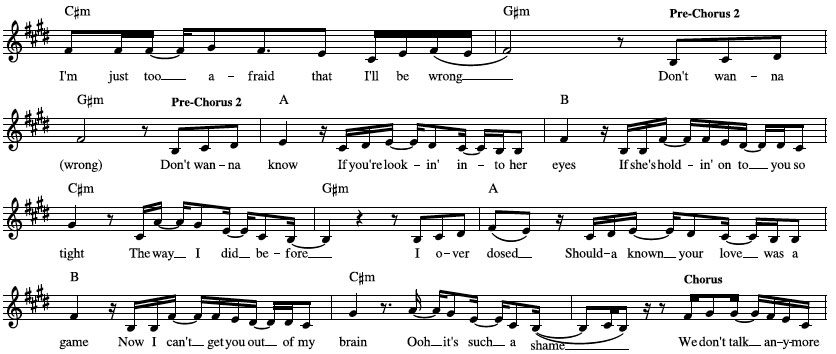

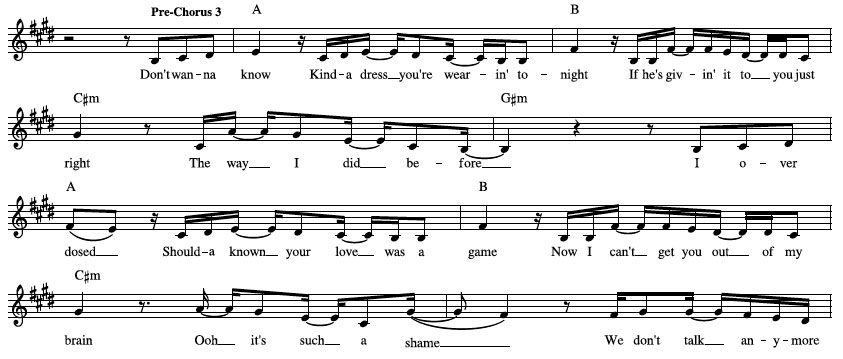

*Note: The graphs above reflect pre-chorus 1. Pre-choruses 2 and 3 feature essentially the same melodic structure.
Line 1: Don’t wan-na know
Line 2: Kind-a dress you’re wea-rin’ to-night
Line 3: If he’s hold-in’ on to you so tight
Line 4: The way I did be-fore
Line 5: I o-ver-dosed
Line 6: Should-a known your love was a game
Line 7: Now I can’t get you out of my brain
Line 8: Ooh it’s such a shame
Line 1: Don’t wan-na know
Line 2: If you’re look-in’ into her eyes
Line 3: If she’s hold-in’ on to you so tight
Line 4: The way I did be-fore
Line 5: I o-ver-dosed
Line 6: Should-a known your love was a game
Line 7: Now I can’t get you out of my brain
Line 8: Ooh it’s such a shame
Line 1: Don’t wan-na know
Line 2: Kind-a dress you’re wear-in’ to-night
Line 3: If he’s giv-in’ it to you just right
Line 4: The way I did before
Line 5: I o-ver-dosed
Line 6: Should-a known your love was a game
Line 7: Now I can’t get you out of my brain
Line 8: Ooh it’s such a shame
High: A4
Low: B3
Parts Structure:
Part X: 1 – 2 – 2 – 3
Part Y: 1 – 2 – 2 – 3
The pre-chorus melody is comprised of three distinct parts, which are denoted as parts 1, 2 and 3. Each stanza features the same 1 – 2 – 2 – 3 parts arrangement, which reinforces the section as a whole with the listener.
Parts 2 and 3 feature pronounced melodic leaps, which accentuate the impact of the section. Both part 2’s conclude with an ascending fifth, and part 3 in both stanzas begins with an ascending sixth and seventh, respectively. Each subsequent leap lands a half-step or whole-step higher than the one that precedes it, which provides each stanza with a highly infectious characteristic.
Each of the song’s three pre-chorus sections features essentially the same vocal melody. The primary difference between the each is the lyrics, and who the lead vocalist is (Puth sings pre-chorus 1, Gomez sings pre-chorus 2, and they both sing in pre-chorus 3). Reference the Vocal Assignments and Story Flow & Meaning sections of the report for details.
Line 1: Don’t wan-na know
Line 2: Kind-a dress you’re wea-rin’ to-night
Line 3: If he’s hold-in’ on to you so tight
Line 4: The way I did be-fore
Line 1, which kicks off the pre-chorus, is composed of part 1a. In contrast to the verse which begins with a primarily stepwise eighth-note DESCENT from A to E, the pre-chorus features a clever melodic direction reversal via a primarily stepwise eighth-note ASCENT from B to E. Notice that both end on the same pitch.
Line 2 is composed of part 2a. In contrast to the rhythm on line 1, which is comprised mostly of eighth notes, it primarily features a combination of sixteenth and eighth notes, which provides infectious contrast. Melodically, it features a straight-forward stepwise ascent/descent up until the last lyric “to-night.” This lyric features a pronounced leap up a fifth from B to F#, consisting of an eighth – quarter note rhythm. This infectious leap motive will play a key role on the lines that follow both within this stanza and the stanza that follows.
Line 3 is composed of part 2b. It features a similar overall structure as line 2 (part 2a) that precedes it, but possesses key differences as well. The most important are:
- It begins a step lower on B, and leaps up a fifth to F# prior to the descent, which is a step above the same point on line 2.
- The last two lyrics/syllables, “so tight” bring the line to a conclusion in the same manner as line 2 via the leap up a fifth. However, both the starting and ending points are a step higher.
Line 4, which is the last line in the stanza, is composed of part 3a. It features similarities with both part 1 and part 2 that precede it.
- Part 2 similarity: It begins in a similar manner as lines 2 and 3 concludes via a pronounced leap. The starting point is the same as line 3, C#, but it ends a half-step higher on A.
- Part 1 similarity: While the melodic direction is the reverse of line 1, descending almost an octave from A to B, it features the same eighth note rhythm up until the last lyric, which is a quarter note.
Line 5: I o-ver-dosed
Line 6: Should-a known your love was a game
Line 7: Now I can’t get you out of my brain
Line 8: Ooh it’s such a shame
The second stanza features almost the same melody and rhythm as the first stanza. The primary differences occur both at the beginning and end of the stanza (lines 1 and 4):
Line 1 (Part 1b): Instead of concluding with a step from D# to E as is the case in the first stanza, the melody leaps a major third, up to F# followed by concluding a step lower on E on the stretched “overdosed” lyric.
Line 4: It begins on B, which is a step lower than its first stanza counterpart, and leaps up to A. As a result, the impact of the leap is more pronounced. Additionally it concludes in a changed-up melismatic manner via the prolonged “sh-a-me” lyric.
Note: The graphs above reflect the lead vocal only.
(Parenthesis): Background vocal
Line 1: We don’t talk an-y-more / (Don’t wan-na know)
Line 2: (Kind-a dress you’re wear-in’ to-night) Oh-oh
Line 3: (If he’s hold-in’ onto you so tight) Oh-oh
Line 4: The way I did before
Line 5: We don’t talk an-y-more / (I o-ver-dosed)
Line 6: (Should-a known your love was a game) Oh-oh
Line 7: (Now I can’t get you out of my brain) Woah-oh
Line 8: Ooh it’s such a shame
High: A4
Low: B3
Parts Structure (Lead Vocal Only)
Part X: 1 – 2 – 3
Part Y: 1 – 2 – 3 – 1
The vocals in the outro is a hybrid of the pre-chorus and chorus melodies and lyrics. The background vocals (shown in the parenthesis above) feature the pre-chorus melody and lyrics, and the lead vocal features the chorus melody and lyrics (save for the additional nonsense lyrics). However, note that there are some subtle differences in the lead vocals compared to the chorus, which keeps the title fresh and engaging as the song heads toward its conclusion.
Each stanza possesses the same part 1 – 2 – 3 core lead vocal structure, which reinforces the melody with the listener. There is, however, a slight difference in part 3 in the second stanza, and the song concludes with an “extra” line, which is a reversion back to the song title, albeit in a modified manner.
Line 1: We don’t talk an-y-more / (Don’t wan-na know)
Line 2: (Kind-a dress you’re wear-in’ to-night) Oh-oh
Line 3: (If he’s hold-in’ onto you so tight) Oh-oh
Line 4: The way I did before
The outro begins with part 1a, which is the same as the chorus title vocal up until the lyric “more,” which is stretched across multiple pitches for an additional two beats. This provides the title with an additional infectious characteristic, and further showcases Puth’s vocal chops. Additionally, note that the lead vocal and “don’t wanna know” background vocal enter at the same time and overlap one another.
Line two is mainly occupied by the background vocals singing pre-chorus lyrics, “kind-a dress you’re wear-in’ to-night.” Charlie Puth chimes in at the end of the line with an “oh-o-oh” nonsense vocal.
Similar to line 2, the background vocals deliver “If he’s hold-in’ onto you so tight,” which is followed by another Puth “oh-o-oh” vocal. Note that this time around the nonsense vocal begins a step higher, which provides a greater sense of excitement in the section.
The last line in the first stanza features the Gomez-delivered “way I did before,” which is almost identical to its counterpart in the pre-chorus. The primary difference is that the lyric “the” (C#) is omitted at the beginning.
Line 5: We don’t talk an-y-more / (I o-ver-dosed)
Line 6: (Should-a known your love was a game) Oh-oh
Line 7: (Now I can’t get you out of my brain) Woah-oh
Line 8: Ooh it’s such a shame
Line 9: That we don’t talk anymore
Line 5 begins much like line 1, with the chorus vocals being delivered by Puth in tandem with the pre-chorus “I overdosed” background vocals.
The background vocals deliver the lyrics “shoulda known your love was a game,” followed by another iteration of the “oh-o-oh” nonsense vocal from Puth, just like in line 2.
The background vocals deliver the lyrics “now I can’t get you out of my brain,” followed by a final “woah-o-oh” nonsense vocal from Puth, which is a step higher than the preceding nonsense vocal just like on line 3. Note that the nonsense vocal this time around is “whoa” as opposed to “oh.”
Puth and Gomez unite on line 8, concurrently singing “ooh it’s such a shame” from the pre-chorus.
The song concludes on a final statement of the main vocal/lyrical/title hook, “we don’t talk anymore.” Its communicated concurrently by Puth and Gomez, with Puth singing it as he does in the chorus, and Gomez speaking it through a telephone / answering machine type of effect.
Lyrics & Title
Lyric Types
The entire song is rich in detail. What follows are a couple of examples from each section. Reference the Story Flow & Meaning section of the report for a full rundown on the narrative.
- I just heard you found the one you’ve been lookin’, you’ve been lookin’ for
- ‘Cause even after all this time I still wonder, why I can’t move on / Just the way you did so easily
- I just hope you’re lyin’ next to somebody, who knows how to love you like me
- Ev’ry now and then I think you might want me to come show up at your door / But I’m just too afraid that I’ll be wrong
- Pre-Chorus 1 (Puth): If he’s holdin’ on to you so tight / The way I did before
- Pre-Chorus 2 (Gomez): If you’re lookin’ into her eyes
- Pre-Chorus 3 (Puth): If he’s givin’ it to you just right / The way I did before
- Pre-Chorus 1, 2, 3 (Puth and Gomez): I overdosed
- Pre-Chorus 1, 2, 3 (Puth and Gomez): Now I can’t get you out of my brain
- We don’t talk anymore
- We don’t love anymore
- Like we used to do
- Pre-Chorus 1: If he’s holdin’ on to you so tight (implied imagery)
- Pre-Chorus 2: If she’s holdin’ on to you so tight (implied imagery)
- Pre-Chorus 3: If he’s givin’ it to you just right (implied imagery)
None
- I just heard you found the one you’ve been lookin’, you’ve been lookin’ for
- ‘Cause even after all this time I still wonder, why I can’t move on / Just the way you did so easily (the act of)
- Ev’ry now and then I think you might want me to come show up at your door (the act of)
- Pre-Chorus 1 (Puth): If he’s holdin’ on to you so tight (the act of)
- Pre-Chorus 2 (Gomez): If you’re lookin’ into her eyes / If she’s holdin’ on to you so tight
- Pre-Chorus 3 (Puth): If he’s givin’ it to you just right
- Pre-Chorus 1, 2, 3 (Puth and Gomez): I overdosed
- We don’t talk anymore
- I wish I would have known that wasn’t me (implied state)
- ‘Cause even after all this time I still wonder, why I can’t move on (implied state)
- But I’m just too afraid that I’ll be wrong
- Part X: All lines feature an implied state of jealousy
- Part Y: I overdosed / Ooh it’s such a shame
- We don’t love anymore
- hey
- Chorus 1, 2, 3, 4: Ooh
- Chorus 2, 3, 4: hey
- hey
- oh-oh
- woah-oh
Rhyme Schemes
XAXA
The first verse features a cross-line rhyme scheme, with the rhyme occurring on lines 2 and 4. Lines 1 and 3 do not rhyme within the section, but ARE connected to the lines in the second verse. Reference verse 2 for details.
Line 1: I just heard you found the one you’ve been look-in’, you’ve been look-in’ for
Line 2: I wish I would have known that was-n’t me
Line 3: ‘Cause e-ven af-ter all this time I still won-der, why I can’t move on
Line 4: Just the way you did so eas-i-ly
Lines 2 and 4 are connected by the “ee” sounding rhyme at the end:
- Line 2: “me”
- Line 4: “eas-i-ly”
Line 1 features the back-to-back repetitive lyrics, “you’ve been lookin’.”
XAXA
The second verse features the same cross-line rhyme structure as the first verse, with the rhyme occurring on lines 2 and 4. However, the sound of the rhyme is different. Additionally, both of the non-rhymers in the first verse (“for” and “on” in lines 1 and 3, respectively) feature a rhyme connection with lyrics in the second verse. This, along with the similar rhyme structure, accentuates the memorability factor of the song.
Line 1: I just hope you’re ly-in’ next to some-bod-y, who knows how to love you like me
Line 2: There must be a good rea-son that you’re gone
Line 3: Ev-’ry now and then I think you might want me to come show up at your door
Line 4: But I’m just too a-fraid that I’ll be wrong
Lines 2 and 4 are connected by the “on” sounding rhyme at the end:
- Line 2: “gone”
- Line 4: “wrong”
- The last lyric on line 1 in the first verse, “for,” which is a non-rhyming line, connects with the last lyric on line 3 in the second verse, “door,” which is also a non-rhyming line.
- The last lyric on line 3 in the first verse, “on,” which is a non-rhyming line, connects with the last lyric in the rhyming lines 2 and 4 in the second verse “gone” and “wrong.”
- The last lyric on line 1 in the second verse, “me,” which is a non-rhyming line, connects with the last lyrics on the rhyming lines 2 and 4 in the first verse, “me” and “easily.”
While the rhyming pattern isn’t consistent from verse to verse, there are only a few select syllables that end lines which helps to connect the seemingly disparate rhyme schemes and make the verse sections feel more familiar overall.
Part X: ABBX
Part Y: ACCC
Each of the song’s three pre-choruses is composed of two stanzas – parts X and Y, both of which feature a different rhyme scheme.
The first stanza (part X) features partially changed up lyrics in each occurrence, but retains the same rhyme scheme. The lyrics and rhyme scheme in each part Y occurrence remain constant.
*Line 1: Don’t wan-na know
Line 2: Kind-a dress you’re wea-rin’ to-night
Line 3: If he’s hold-in’ on to you so tight
*Line 4: The way I did be-fore
*Line 1: Don’t wan-na know
Line 2: If you’re look-in’ into her eyes
Line 3: If she’s hold-in’ on to you so tight
*Line 4: The way I did be-fore
*Line 1: Don’t wan-na know
Line 2: Kind-a dress you’re wea-rin’ to-night
Line 3: If he’s giv-in’ it to you just right
*Line 4: The way I did be-fore
*Lines 1 and 4 remain the same in each pre-chorus occurrence.
Line 5: I o-ver-dosed
Line 6: Should-a known your love was a game
Line 7: Now I can’t get you out of my brain
Line 8: Ooh it’s such a shame
Lines 2 and 3 in part X of each pre-chorus are connected by the “eye” sounding rhyme at the end:
- Pre-Chorus 1: “to-night” / “tight”
- Pre-Chorus 2: “to-night” / “right”
- Pre-Chorus 3: “eyes” / “tight”
Lines 6, 7 and 8 in part Y of each pre-chorus are connected by the “ame” / “ain” sounding rhyme at the end:
- Line 6: “game”
- Line 7: “brain”
- Line 8: “shame”
The first line in part X and part Y of each pre-chorus is connected by the “oh” sounding commonality:
- Line 1 (part X): “know”
- Line 5 (part Y): “o-ver-dosed”
Line 2 in part X of the first and third pre-chorus sections is connected is to line 6 in part Y by the “kind-a” and “should-a” commonality.
Although line 4 doesn’t rhyme with any of the other lines in each pre-chorus, it is connected with the verse, chorus, and outro via the “or” sounding commonality:
- Pre-Chorus, line 4: “The way I did be-fore”
- Verse 1, line 1: “for”
- Verse 2, line 3: “door”
- Chorus, lines 1 – 3: “an-y-more”
- Outro, line 1, 4, 5, 9: “an-y-more”, “be-fore”
Part X: AAAB
Part Y: AAAB
Both parts/stanzas in the chorus feature the same core rhyme scheme and feature many of the same lyrics. As a result, the ability of the section to connect with the listener and easily get ingrained in their head is accentuated.
Line 1: We don’t talk an-y-more (*We don’t we don’t)
Line 2: We don’t talk an-y-more (*We don’t we don’t)
Line 3: We don’t talk an-y-more
Line 4: Like we used to do
Line 5: We don’t love an-y-more (*We don’t we don’t)
Line 6: What was all of it for (Ooh) (*We don’t we don’t)
Line 7: We don’t talk an-y-more
Line 8: Like we used to do
*Choruses 2 & 3 only
Lines 1, 2, and 3 in part X of each chorus is composed of the title lyrics, “we don’t talk anymore.”
In the second and third choruses, lines 1 and 2 are directly followed by the background vocals “we don’t, we don’t.”
Lines 1, 2 and 3 in part Y of each chorus are connected by the “or” sounding rhyme at the end:
- Line 5: “an-y-more”
- Line 6: “for”
- Line 7: “an-y-more”
Additionally, in the second and third choruses, lines 5 and 6 are directly followed by the background vocals “we don’t, we don’t.”
Both parts/stanzas in each chorus feature the same core rhyme scheme. The lyrics are the same as well, except for the lyric “love” in line 5, and all of line 6, “what was all of it for.”
Part X: ABBA
Part Y: ACCC
The outro is essentially a hybrid of the chorus and pre-chorus. The first and last lines in both parts/stanzas (lines 1, 4 and 5, 8) feature chorus lyrics and are communicated via the primary lead vocal. However, lines 1 and 5 feature a processed background vocal overlay of the first line of the pre-chorus as well. The middle lines in each part/stanza (lines 2, 3 and 6, 7) feature the pre-chorus background vocals, each of which is followed by the nonsense “oh-oh” vocal, which is communicated by the lead.
Reference the breakdown below, and listen as you go through it in order to get the full picture of how it all comes together.
Line 1: We don’t talk an-y-more / (Don’t wan-na know)
Line 2: (Kind-a dress you’re wear-in’ to-night) Oh-oh
Line 3: (If he’s hold-in’ onto you so tight) Oh-oh
Line 4: The way I did be-fore
Line 5: We don’t talk an-y-more / (I o-ver-dosed)
Line 6: (Should-a known your love was a game) Oh-oh
Line 7: (Now I can’t get you out of my brain) Woah-oh
Line 8: Ooh it’s such a shame
Line 9: We don’t talk an-y-more
Song Title
Song titles fall within one of two categories – those that are unique, clever, attention grabbing and/or possess a powerful nature (e.g. “7 Years”, “Cake By The Ocean,” “I Took A Pill In Ibiza”), and those that possess more of a universal/generic characteristic (e.g. “Can’t Stop The Feeling”, “Like I’m Gonna Lose You”).
We Don’t Talk Anymore is on the generic end of the spectrum. However, its powerful connotation coupled with the “soap opera factor” (i.e. since Selena Gomez is featured on the track, can it possibly pertain to her ex Justin Bieber?) will further pique the curiosity of the listener to check out the song.
We Don’t Talk Anymore is featured 19 times throughout the song. It appears four times in each of the song’s four chorus sections – the first three in a back-to-back manner in the first stanza/part X, and once on the second to last line in the second stanza/part Z.
Its featured three times in the outro as well – at the beginning of each stanza as well as the last line in the entire song.
We don’t talk anymore
We don’t talk anymore
We don’t talk anymore
Like we used to do
We don’t love anymore
What was all of it for (ooh)
We don’t talk anymore
Like we used to do
We don’t talk anymore / (Don’t wanna know)
(Kinda dress you’re wearin’ tonight) Oh-oh
(If he’s holdin’ on to you so tight) Oh-oh
Way I did before
We don’t talk anymore / (I overdosed)
(Shoulda known your love was a game) Oh-oh
(Now I can’t get you out of my brain) Woah-oh
Ooh it’s such a shame
We don’t talk anymore
The following characteristics accentuate the impact of the title, We Don’t Talk Anymore, throughout the song:
Part X
In the first stanza/part X of the chorus, the song title is repeated three consecutive times in a very similar manner. This, coupled with the half rest that follows the first two occurrences, enables the title to easily connect and resonate with the listener.
Part Y
The second stanza/part Y features an almost identical melodic structure, save for the “oo-ooh” vocal that follows line 2. However, note that the lyrics are different on lines 1 and 2. Despite the lyrical differences, the song title melody is further reinforced with the listener.
The song title vocal duties are changed up throughout the song, which helps to keep it fresh and engaging despite its repetitive characteristics:
- Chorus 1: Puth
- Chorus 2: Puth
- Chorus 3: Puth and Gomez (Gomez is at the forefront of the mix)
- Chorus 4: Puth and Gomez
- Outro: Puth and Gomez (Puth is at the forefront of the mix. Gomez enters on the very last line)
The song title is conveyed by Puth in both a similar and infectiously changed up manner in the outro compared to the chorus sections. As a result, the similarity reinforces the title with the listener, while the differences helps keep it fresh and engaging – in addition to providing Puth with another opportunity to show off his vocal chops.
Additionally, the final “we don’t talk anymore” statement in the song is conveyed by both Puth and Gomez concurrently. Gomez’s vocal is heavily-effected, and possesses a spoken telephone / answering machine type effect, which is unique in the scope of the song.
Word Cloud
Story Flow & Meaning
We Don’t Talk Anymore is a downtrodden love/relationship themed song about two people who were involved in a relationship, broke up, still care for one another, and are trying to remain as friends or acquaintances. However, neither wants to know of the other’s new relationship exploits, hence the wrench in them still talking.
Per Charlie Puth in an interview with Metro:
“As for lyrical sentiment, I think it fits so well for her [Gomez] to be on [the song] because everyone knows what she went through. And I think everyone has had those relationships where you’re obsessed with that one person, but then you break it off peacefully, but it’s changed. You can’t talk to them like friends anymore. You can say you want to remain friends, but it’s easier said than done. It’s heartbreaking. We Don’t Talk Anymore is basically the conversation a month after that type of breakup.”
The impact of the narrative (and the song as a whole) is accentuated by the clever and effective structuring of the Puth (protagonist) / Gomez (antagonist) duet:
Chorus
- Chorus 1: Protagonist
- Chorus 2: Protagonist
- Chorus 3: Antagonist
- Chorus 4: Protagonist and Antagonist
Verse
- Verse 1: Protagonist
- Verse 2: Antagonist
Pre-Chorus
- Pre-Chorus 1: Protagonist
- Pre-Chorus 2: Antagonist
- Pre-Chorus 3: Protagonist and Antagonist
Outro
- Protagonist and Antagonist
Most Top 10 hit pre-choruses typically feature the same lyrics from occurrence to occurrence. However, that’s only partially the case with We Don’t Talk Anymore. Consisting of two parts/stanzas, each pre-chorus features core lyrical similarities, but also contains changeups depending on whether the lyrics are being delivered by the protagonist or antagonist.
Pre-Chorus Commonalities
- First Stanza/Part X: Each begins and ends with the same lyrics, which relate to both the protagonist and antagonist.
- Second Stanza/Part Y: Features the same lyrics from occurrence to occurrence, relating to both the protagonist and antagonist.
Pre-Chorus Differences
Lines 2 and 3 in part X of each pre-chorus relate specifically to the protagonist or antagonist.
- Pre-Chorus 1 (Protagonist)
- Pre-Chorus 2 (Antagonist)
- Pre-Chorus 3 (Protagonist)
The narrative is communicated in a universal manner, which enables it to easily connect and resonate with a wide audience. Since there is no mention of specific details that relate to both the protagonist and antagonist (i.e. the specific reason for their breakup, or the specifics regarding their relationship), the listener can adapt the story to fit their own life’s circumstances.
Puth’s decision to feature Selena Gomez on the track was a good one beyond just what she could contribute vocally. Gomez’s fans are well aware of her relationship history with Justin Bieber, and as a result would be more intrigued to check out the song and get engrossed in the narrative to see how it possibly relates. Ultimately this will lead to increased exposure and sales of Puth’s song.
Key
Green Font: The protagonist is communicating
Red Font: The antagonist is communicating
Blue Font: The protagonist and antagonist are communicating concurrently
Line 1: We don’t talk anymore
Line 2: We don’t talk anymore
Line 3: We don’t talk anymore
Line 4: Like we used to do
Line 5: We don’t love anymore
Line 6: What was all of it for (ooh)
Line 7: We don’t talk anymore
Line 8: Like we used to do
Unlike the vast majority of recent Top 10 hits, We Don’t Talk Anymore immediately begins with the chorus. As a result, the listener is introduced to the narrative summation/payoff right off the bat without any lead-in from the verse or pre-chorus.
The first line in a song is among the most important. Why? Because it needs to instantly grab the listener’s attention and pique their curiosity for what comes next. This is exactly what the first line in We Don’t Talk Anymore achieves.
Lines 1, 2 & 3: “We don’t talk anymore”
Line 1, as well as lines 2 and 3 that follow feature the title, “we don’t talk anymore.” Since this is half of the narrative’s summation (the other half follows at the end of the stanza), it piques the listener’s curiosity as to what “we don’t talk anymore” relates to.
Line 4: “Like we used to do”
The last line in part X, “like we used to do,” is the second half of the narrative summation. It, along with the title lines that precede it, convey key information about the song without the need to outright say it. The listener can infer:
- The protagonist (communicated by Puth) was, or still is, in a relationship with a yet-to-be established antagonist. The type of relationship, however, is yet to be defined.
- The nature of the relationship between the protagonist antagonist has changed. While they still communicate with one another, it’s not like it used to be.
The first two lines in the second stanza/part Y provide an important development in the narrative:
Line 5: “We don’t love anymore”
Line 6: “What was all of it for”
Line 5 establishes that the protagonist and antagonist were in a love-based relationship. The fact that they “don’t love anymore” indicates that the love aspect of their relationship has ended.
Line 6 sums up what just about anyone who has been a relationship that has ended feels – “what was all of it for?”
Line 7: “We don’t talk anymore”
Line 8: “Like we used to do”
The last two lines in the second stanza/part Y reiterate the last two lines of the first stanza/part X. However, this time around they provide the narrative with additional inferred meaning following the development on lines 5 and 6:
- The protagonist and antagonist still communicate with one another. However, now that they have broken up it’s not the same.
- The protagonist and antagonist are trying to remain as friends or acquaintances following the breakup.
In the scope of the song, the chorus is communicated by the protagonist (choruses 1 and 2), the antagonist (chorus 3), and by both the protagonist and antagonist concurrently (chorus 4). In addition to helping to keep the chorus fresh and engaging throughout the song, it also establishes that both the protagonist and antagonist are on the same page regarding the nature of their relationship.
Line 1: I just heard you found the one you’ve been lookin’, you’ve been lookin’ for
Line 2: I wish I would have known that wasn’t me
Line 3: ‘Cause even after all this time I still wonder, why I can’t move on
Line 4: Just the way you did so easily
The first verse continues on with the protagonist’s P.O.V. following the first chorus. It features him communicating either directly or indirectly to the antagonist. Here the listener learns the following:
- Line 1: The antagonist has found a new love interest following the breakup.
- Lines 2 & 3: The protagonist still has feelings for the antagonist, and continues to dwell on her.
- Lines 2 & 3: It can be inferred that the protagonist feels that he was wasting his time dwelling on the antagonist, considering that she was looking for someone else besides him.
- Line 4: Unlike him, the protagonist assumes that the antagonist was able to “move on” easily after the end of the relationship.
Line 1: I just hope you’re lyin’ next to somebody, who knows how to love you like me
Line 2: There must be a good reason that you’re gone
Line 3: Ev’ry now and then I think you might want me to come show up at your door
Line 4: But I’m just too afraid that I’ll be wrong
The second verse switches to the antagonist’s P.O.V., communicated by Gomez. As is the case with the first verse, it features her communicating either directly or indirectly to the antagonist. The listener learns the following:
- Line 1: The antagonist cared a lot about the protagonist. Note that the line can be interpreted as her loving him in a sexual or non-sexual manner.
- Line 2: The protagonist broke up with the antagonist (inferred).
- Line 3: The antagonist still has feelings for the protagonist, and thinks the protagonist may also.
- Line 4: The antagonist is unsure if the protagonist still has feelings for her, and isn’t taking the chance.
Line 1: Don’t wanna know
Line 2: Kinda dress you’re wearin’ tonight
Line 3: If he’s holdin’ on to you so tight
Line 4: The way I did before
Line 1: Don’t wanna know
Line 2: If you’re lookin’ into her eyes
Line 3: If she’s holdin’ on to you so tight
Line 4: The way I did before
Line 1: Don’t wanna know
Line 2: Kinda dress you’re wearin’ tonight
Line 3: If he’s givin’ it to you just right
Line 4: The way I did before
Line 5: I overdosed
Line 6: Shoulda known your love was a game
Line 7: Now I can’t get you out of my brain
Line 8: Ooh it’s such a shame
We Don’t Talk Anymore features three pre-chorus sections in its framework. The first pre-chorus is communicated by solely the protagonist, the second solely by the antagonist, and the third by both the protagonist and antagonist on specific lines.
Each of the song’s three pre-choruses consists of two parts/stanzas. The second stanza/part Y features the same lyrics in each occurrence. Each iteration of the first stanza/part X features the same lyrics on lines 1 and 4 (“don’t wanna know” / “the way I did before”), but features a changeup on lines 2 and 3, which pertains directly either to the protagonist or antagonist.
The commonality between all three pre-chorus sections is that they revolve around jealousy. In each case, the protagonist or antagonist “doesn’t want to know” if the other’s new lover is filling the void of their absence in “the way they did before” (lines 1 and 4, respectively):
Part X
Pre-Chorus 1 (Protagonist)
- Line 2: Kinda dress you’re wearin’ tonight
- Line 3: If he’s holdin’ on to you so tight
Pre-Chorus 2 (Antagonist)
- Line 2: If you’re lookin’ into her eyes
- Line 3: If she’s holdin’ on to you so tight
Pre-Chorus 3 (Protagonist)
- Line 2: Kinda dress you’re wearin’ tonight
- Line 3: If he’s givin’ it to you just right
Note that line 2 in the third pre-chorus is the same as line 2 in the first pre-chorus. However, line 3 is new, and introduces sex into the mix.
Part Y
The following is established in the second stanza/part Y of each pre-chorus.
- Line 5: They fell head-over-heels for one another.
- Line 6: In retrospect, both feel that the other didn’t take the relationship seriously.
- Lines 7 & 8: They still dwell on each other, and regret that the relationship didn’t work out.
Line 1: We don’t talk anymore / (Don’t wanna know)
Line 2: (Kinda dress you’re wearin’ tonight) Oh-oh
Line 3: (If he’s holdin’ on to you so tight) Oh-oh
Line 4: The way I did before
Line 5: We don’t talk anymore / (I overdosed)
Line 6: (Shoulda known your love was a game) Oh-oh
Line 7: (Now I can’t get you out of my brain) Woah-oh
Line 8: Ooh it’s such a shame
Line 9: That we don’t talk anymore
The outro is a narrative hybrid of the pre-chorus and chorus. The majority is communicated solely from the protagonist’s P.O.V., except for line 4 which is communicated solely by the antagonist.
What’s clever is that they both come together on the last line in the section, “we don’t talk anymore.” While Puth is singing the title, Gomez is speaking the title in an effected voice which gives the impression of a telephone or playback on an answering machine. Notice that the title isn’t followed by “like we used to do” this time around. As a result, it infers that the protagonist and antagonist simply “don’t talk anymore.”
This section compares We Don’t Talk Anymore to the 23 songs that landed in the Billboard Hot 100 Top 10 during Q2-2016
* A-B-A-B-(D)-B: This form includes both bridge and bridge surrogate sections (A-B-A-B-C-B, A-B-A-B-IB-B, A-B-A-B-VB-B).
**”D” Section: A section that provides a pronounced departure in the scope of a song.
We Don’t Talk Anymore shares the following compositional characteristics that were most popular among the 23 songs that charted in the Hot 100 Top 10 during Q2-2016. The commonalities make it easier for a mainstream audience to connect with the song, especially in an airplay environment due to the familiarity they impart (i.e. the song isn’t coming out of left field which would cause the listener to have to work at connecting with the song).
We Don’t Talk Anymore being in-line with the most popular (#1) characteristics of Q2-2016’s Top 10 charting hits:
- Primary Genre: Pop
- Influences: Electropop
- Primary Lyrical Theme: Love/Relationships
- Song Title Placement: Chorus
- Prominent Instrumentation: Drums/Perc
- Song Length Range: 3:30 – 3:59
- Last Section: Outro
- Includes the Following Sections: Pre-Chorus, Post Chorus, “D” Section (departure), Instrumental Break
- Influences: R&B/Soul
- Instrumentation: Bass, Synth
- Electronic Vs. Acoustic Instrumentation: Acoustic/Electronic Combo
- Outro Length Range: 0:20 – 0:29
Additionally, We Don’t Talk Anymore features a Tropical influence, which is very popular in the current mainstream music scene.
- Credited Songwriters: Three
- Lead Vocal Gender: Duet
- Song Title Appearances: 16 – 20 range
- Form: B-A-B-A-B-IB-B
- First Section: Chorus







